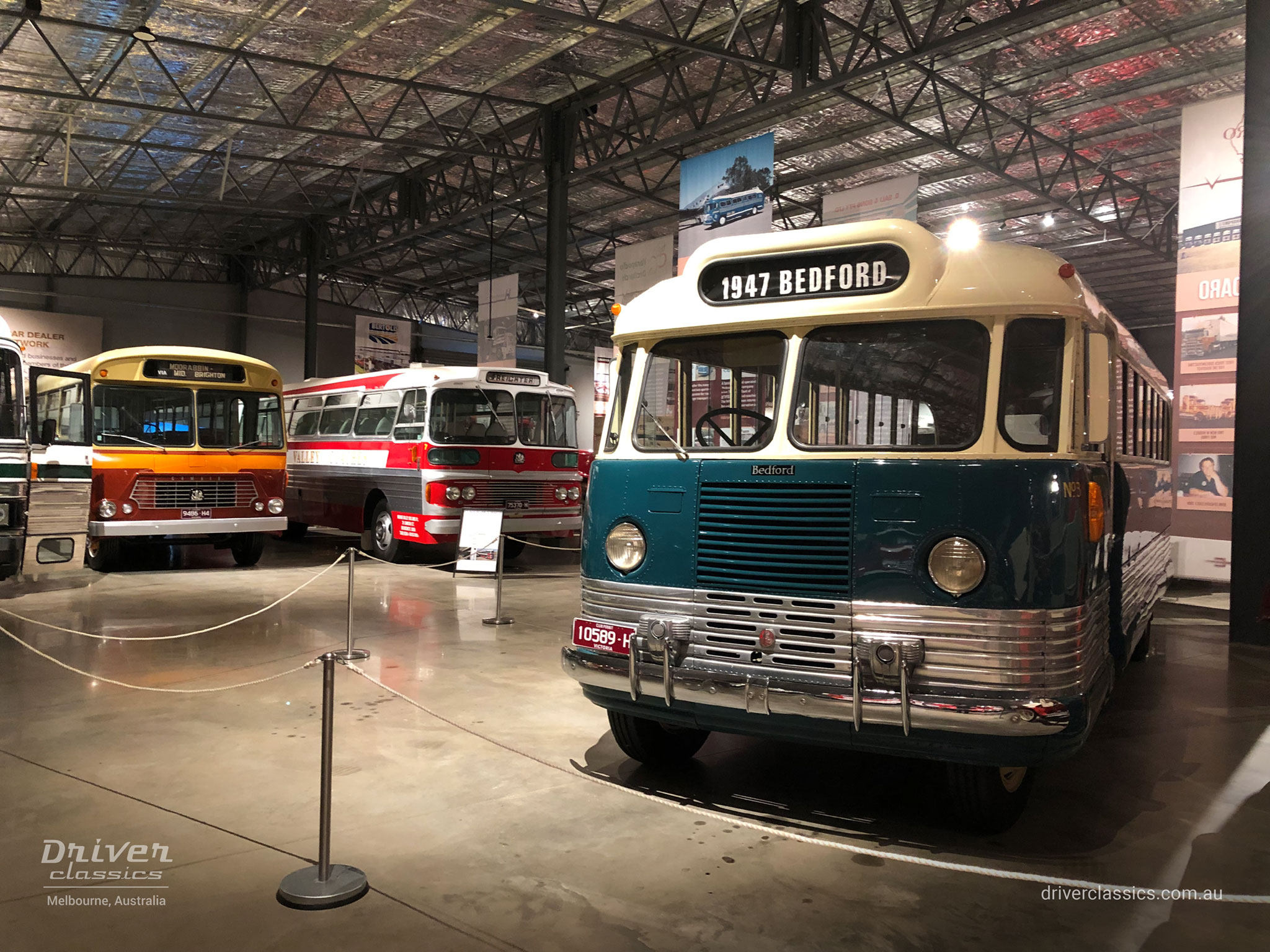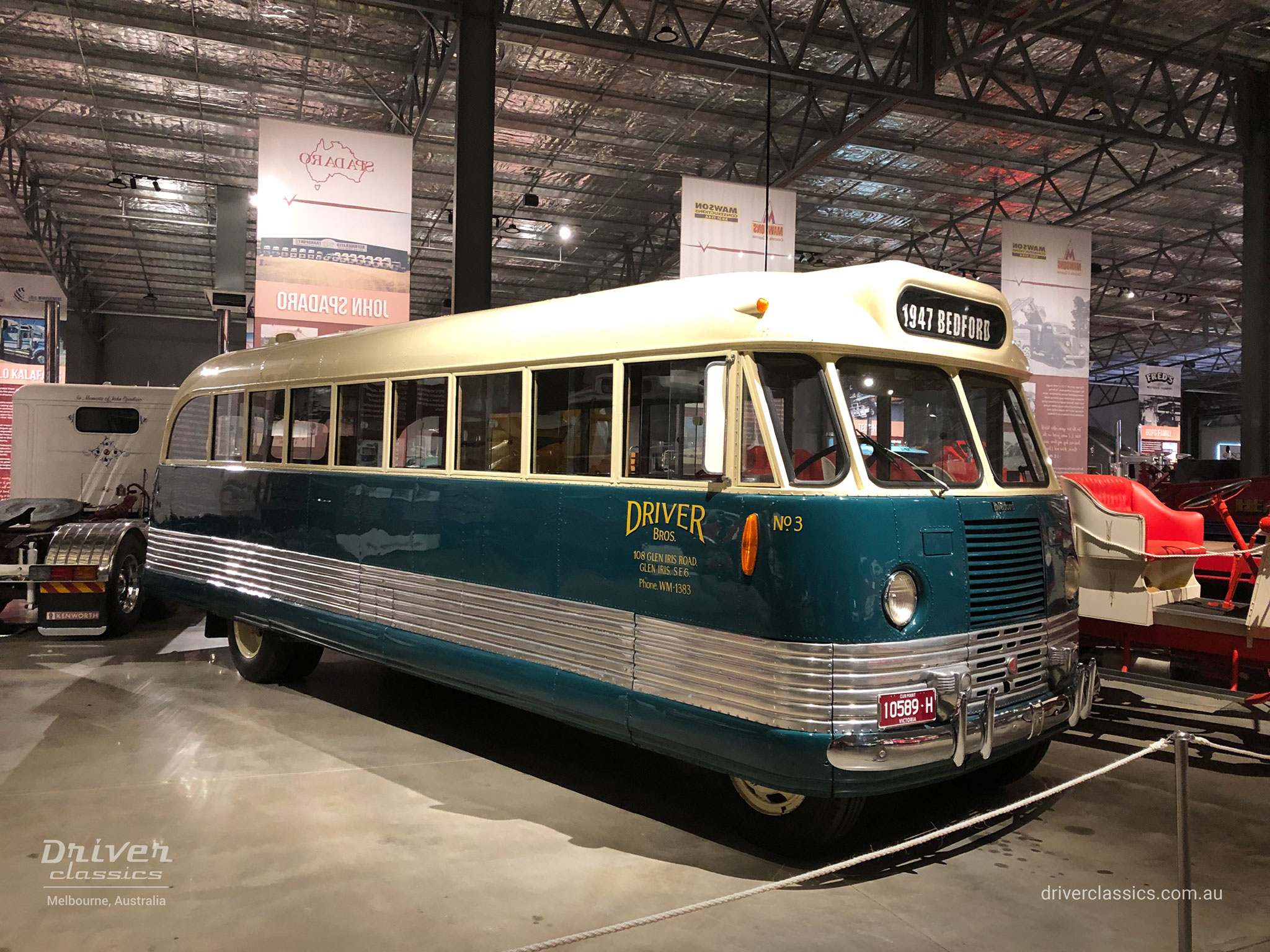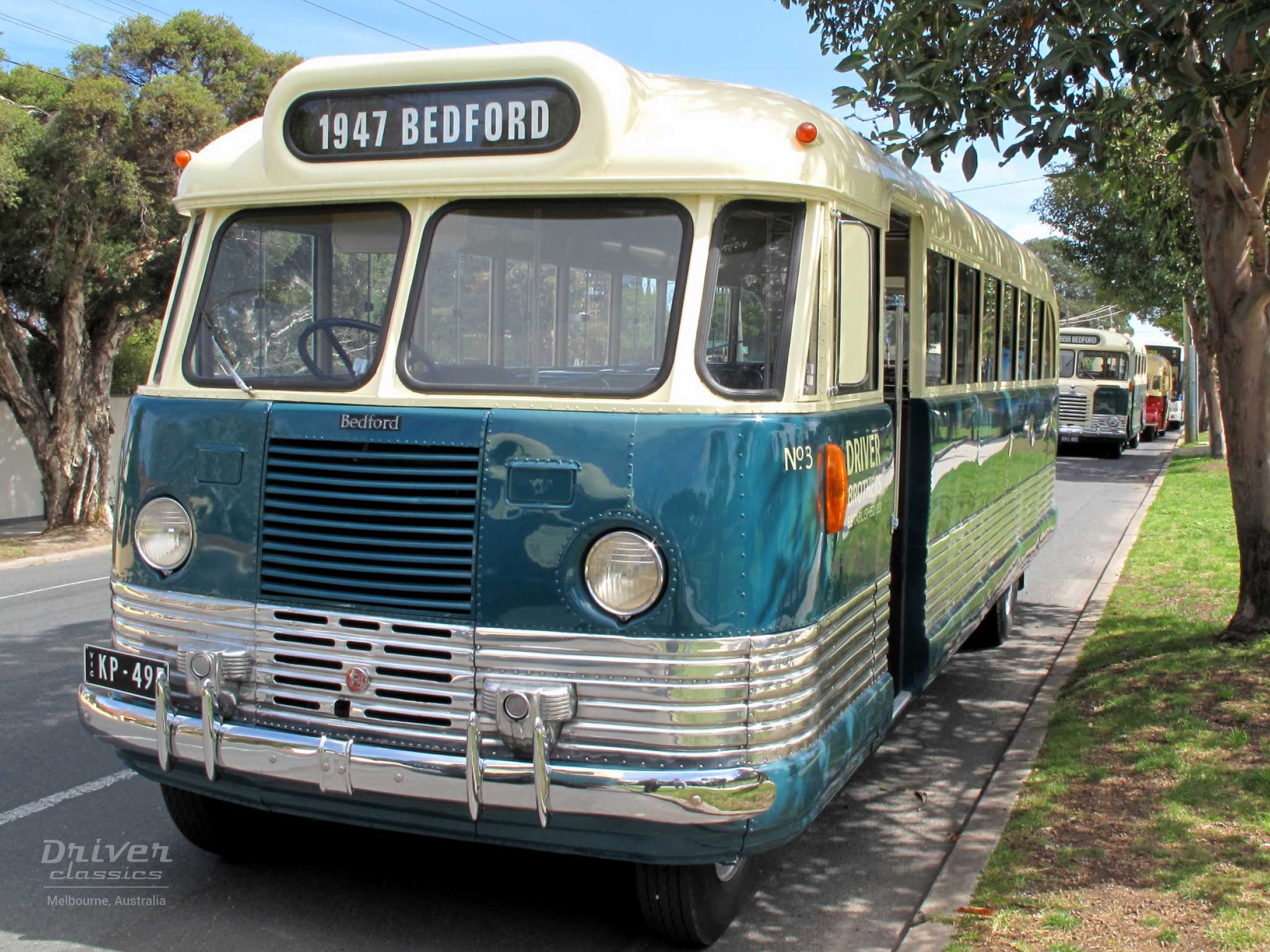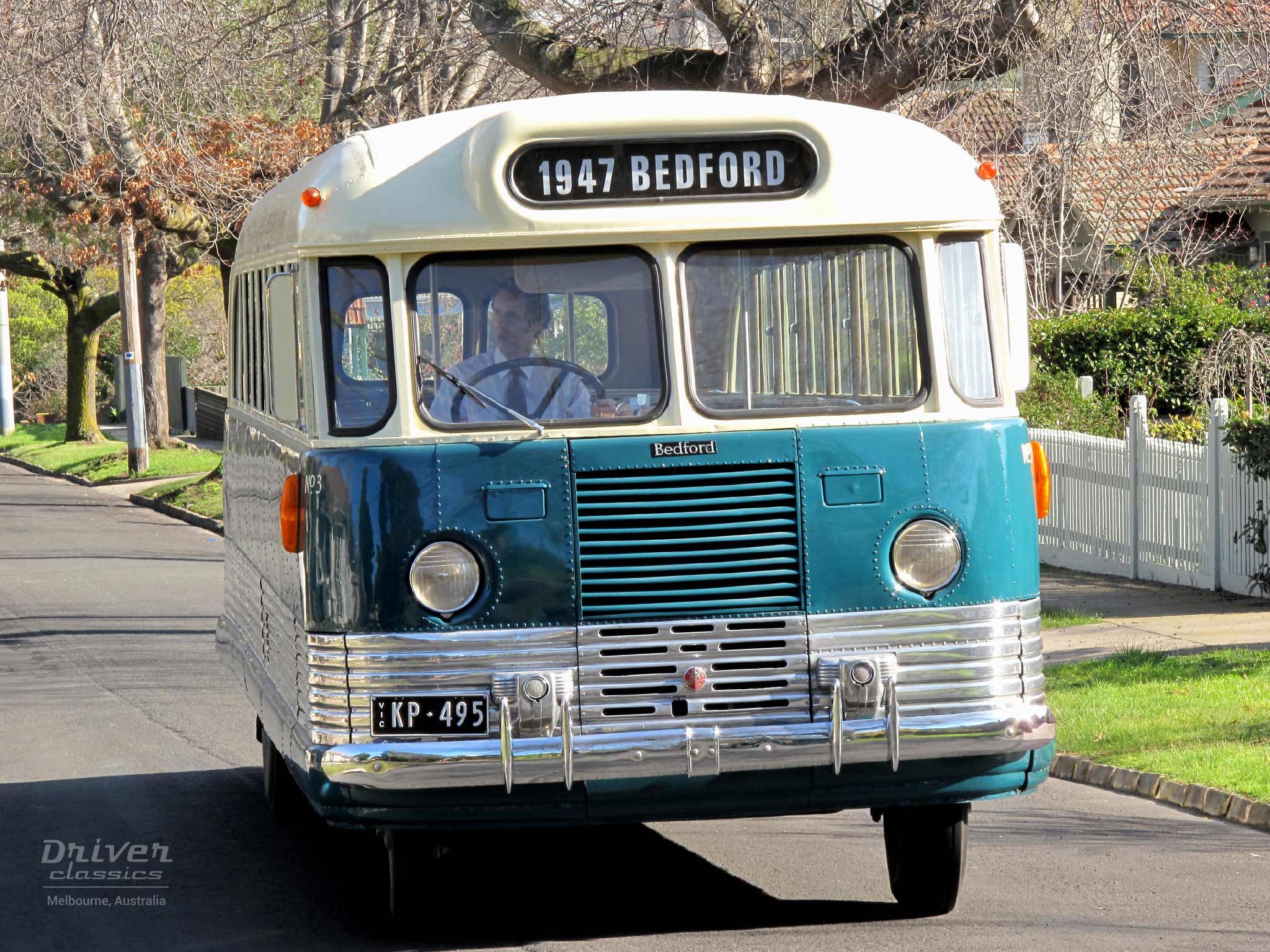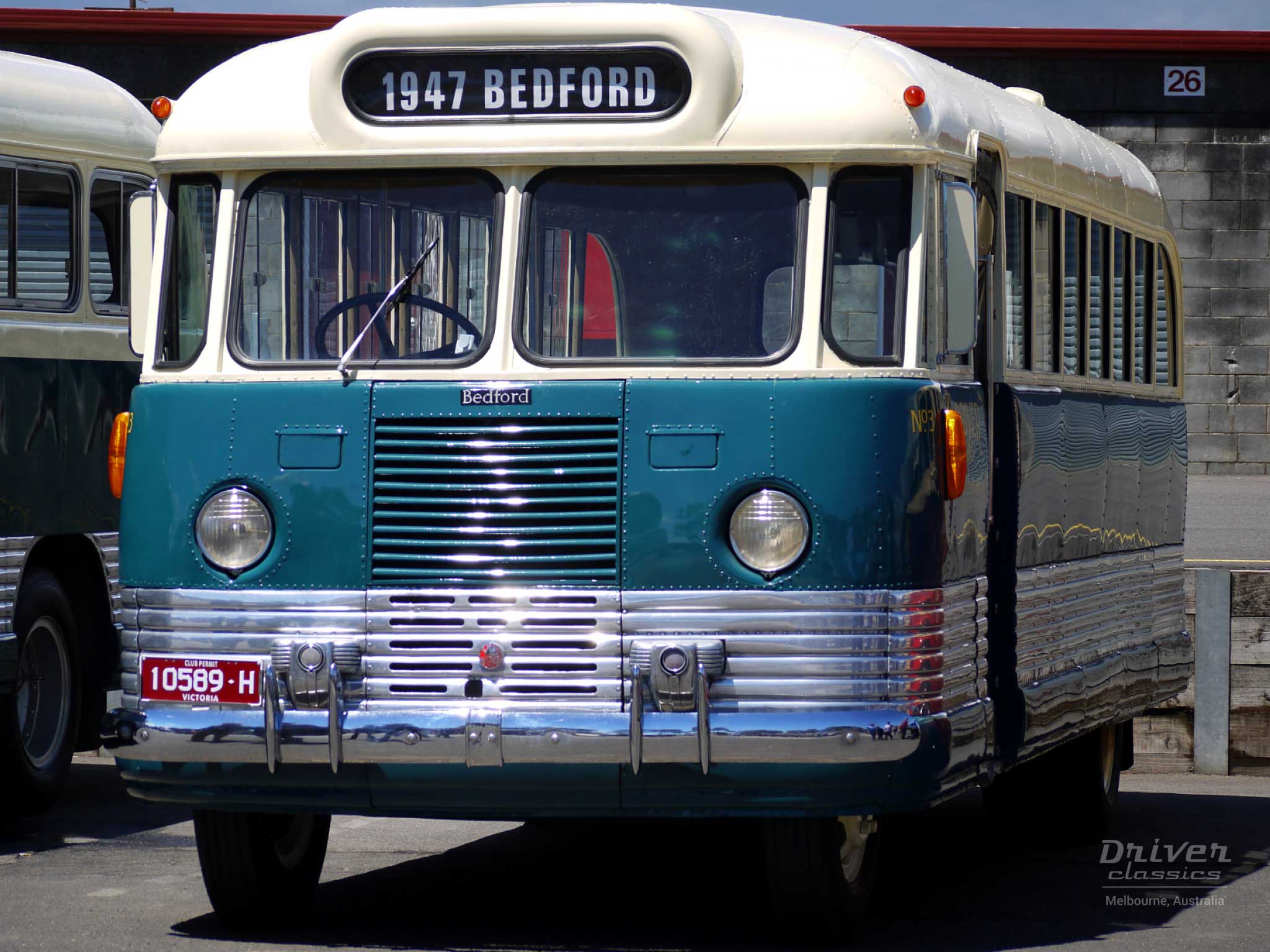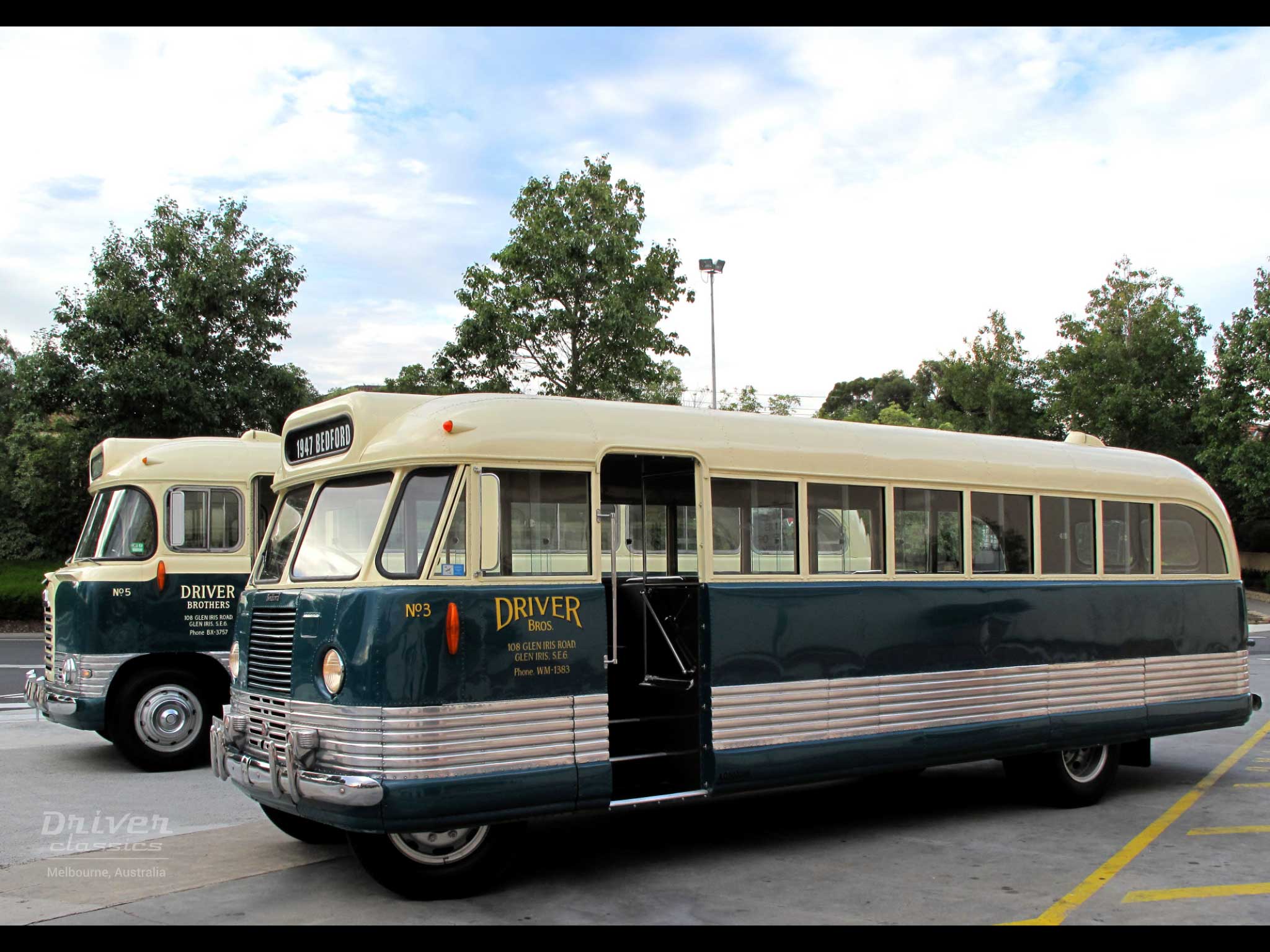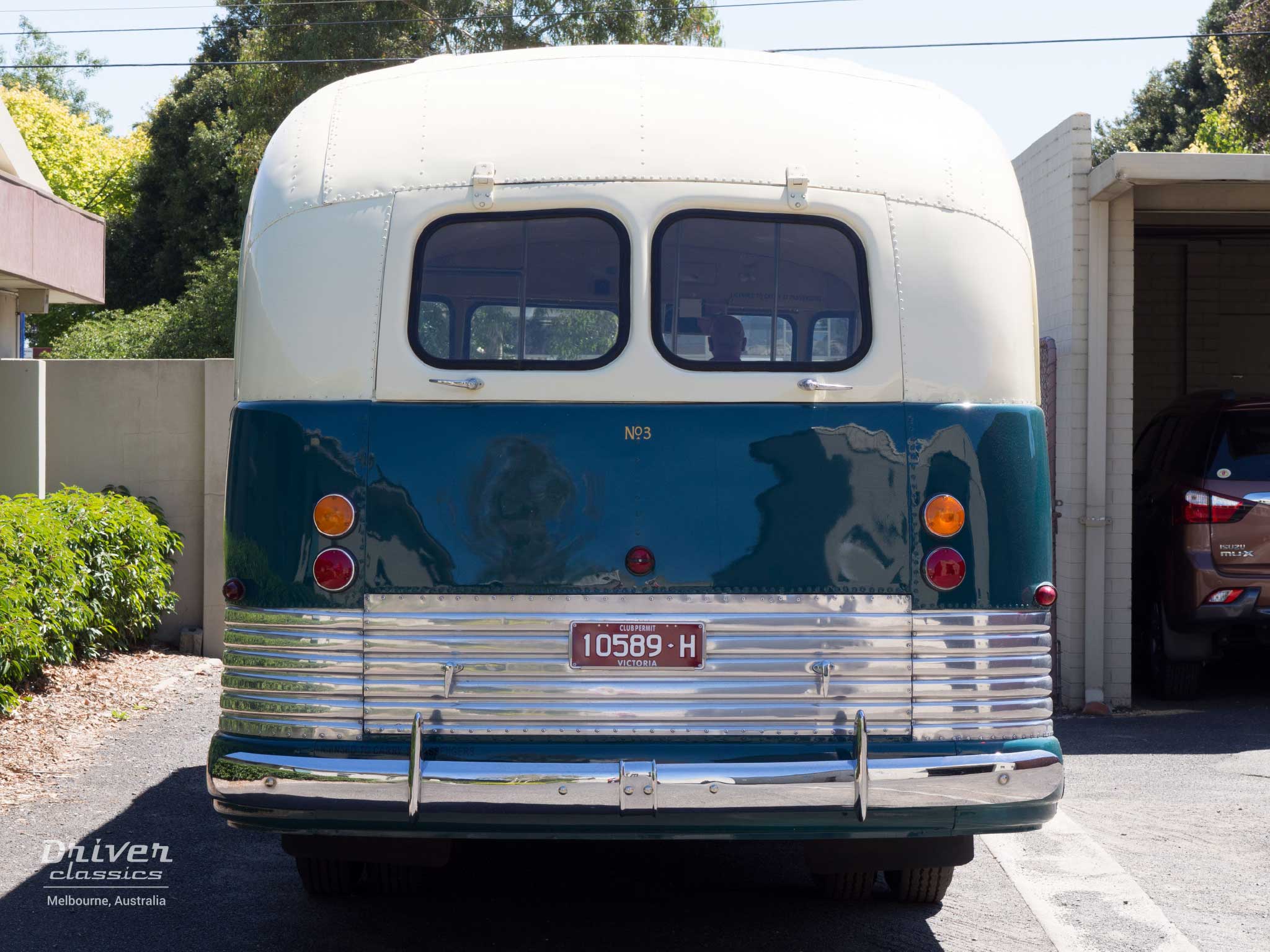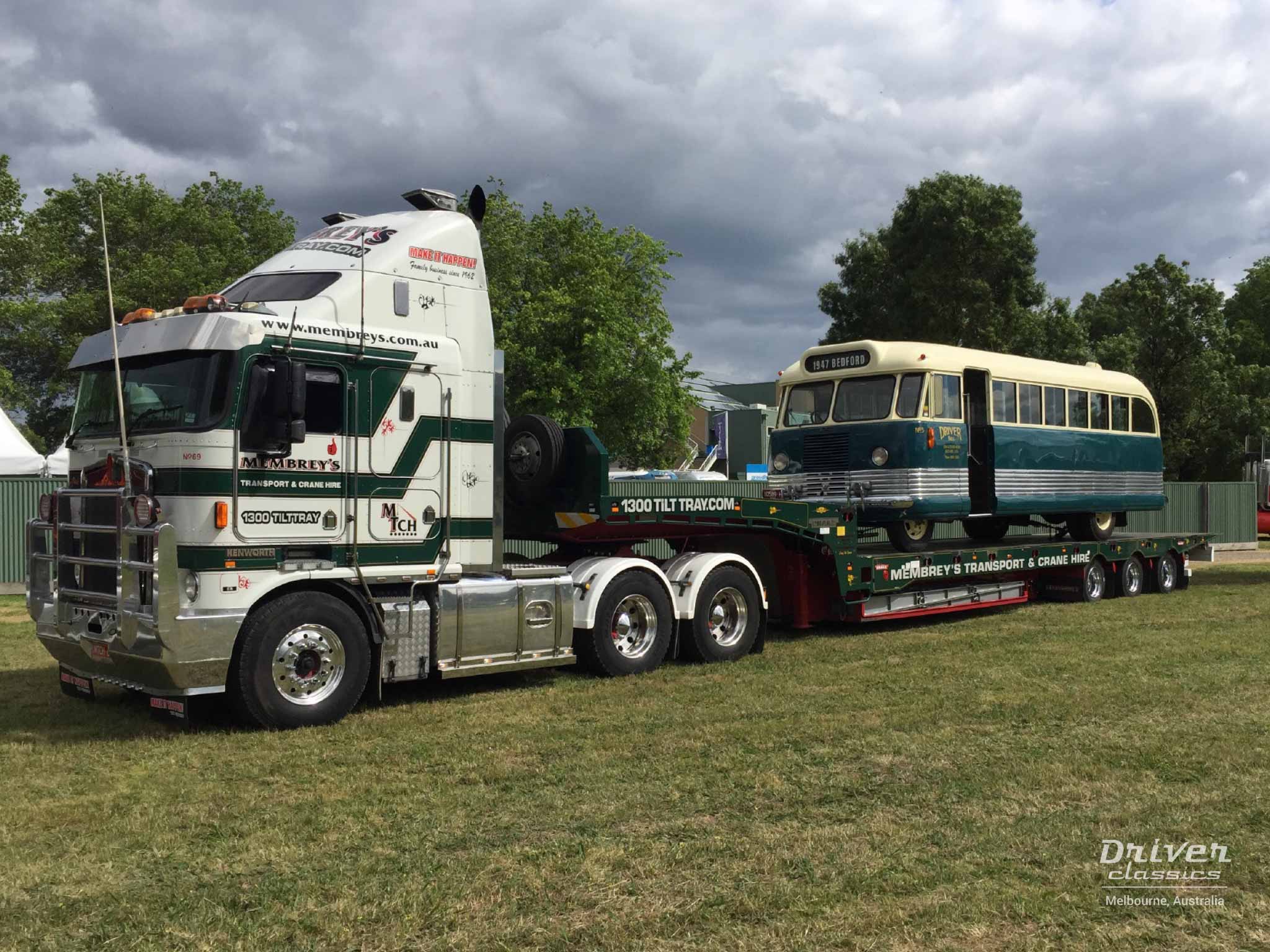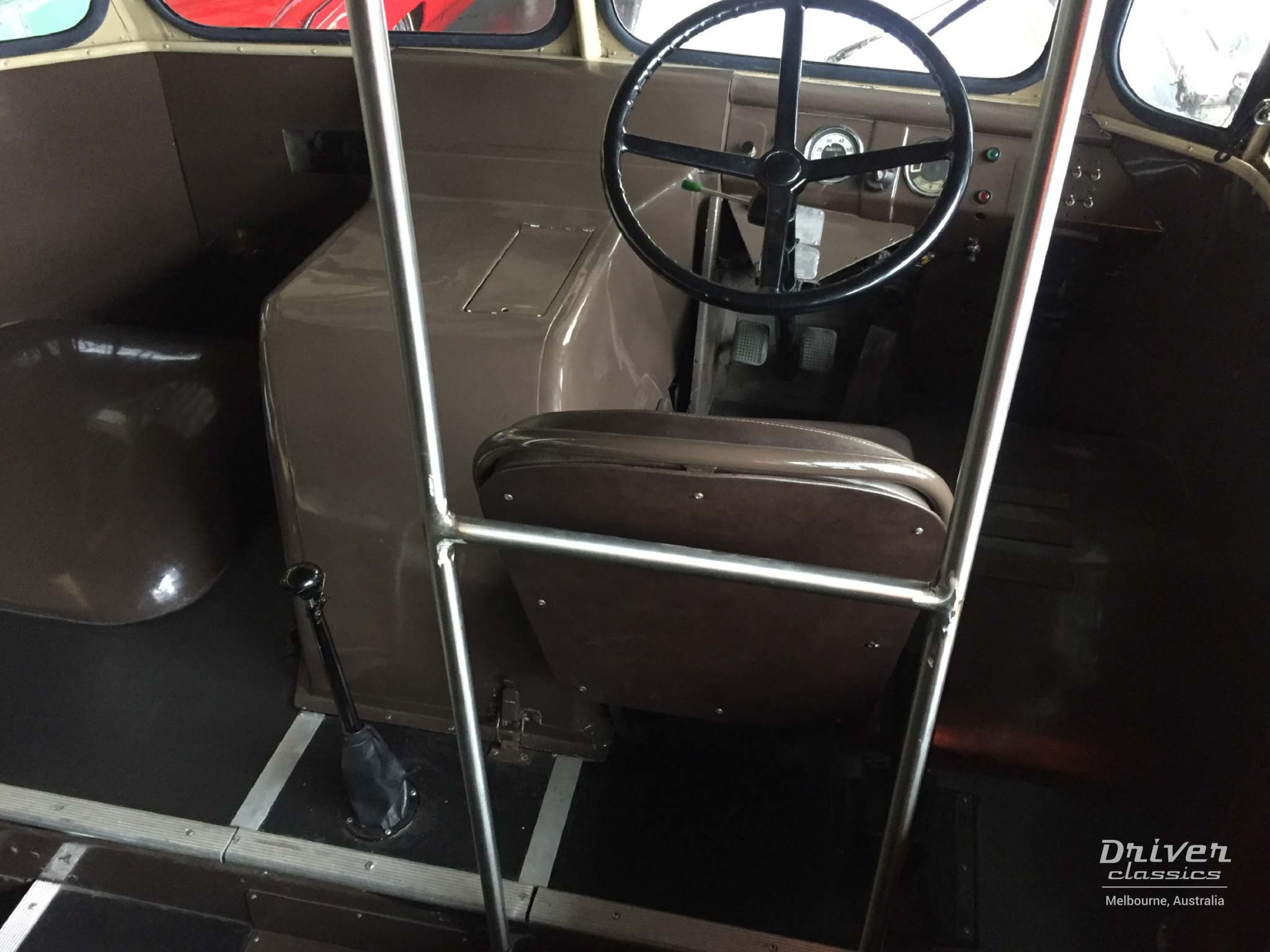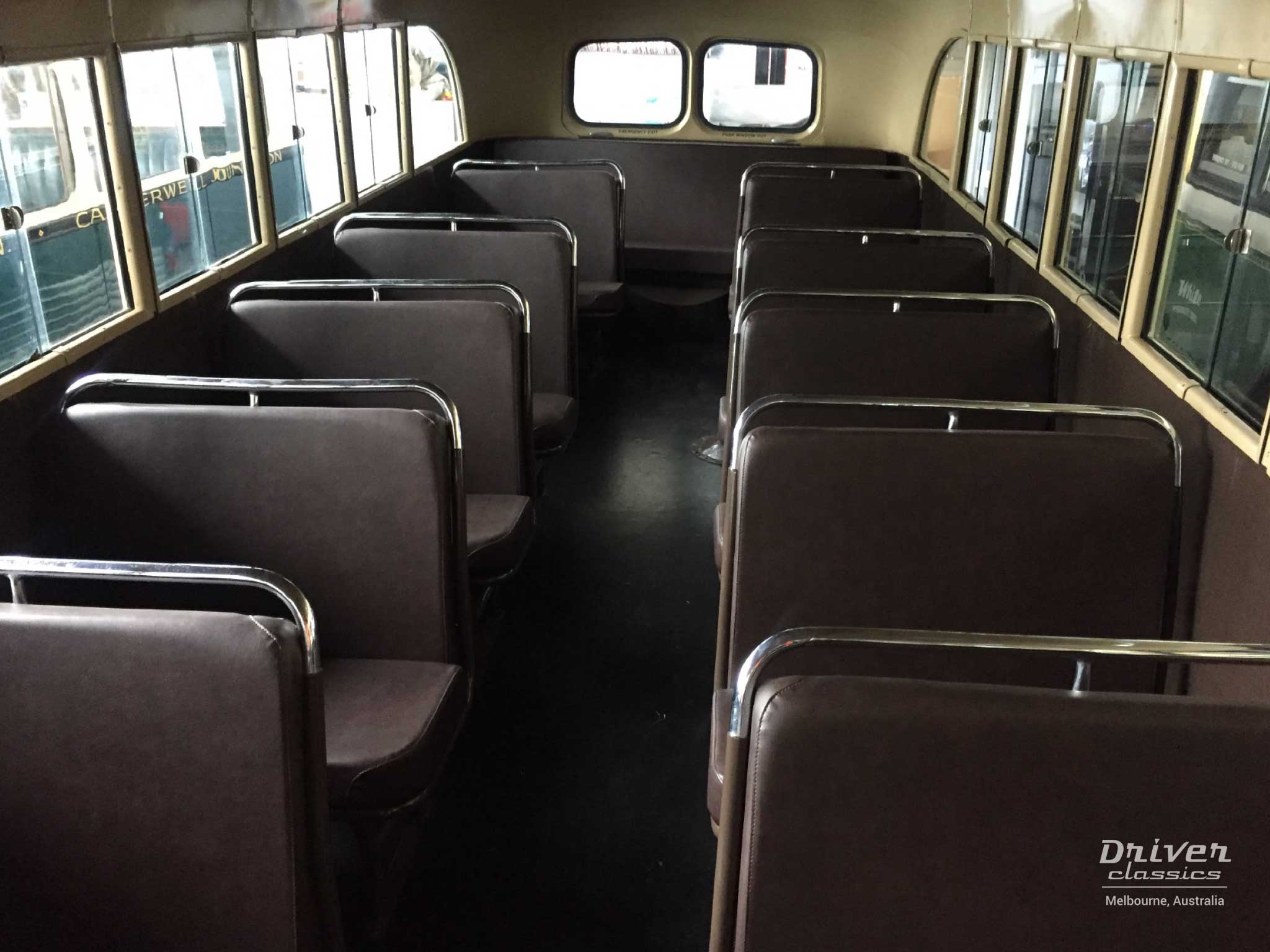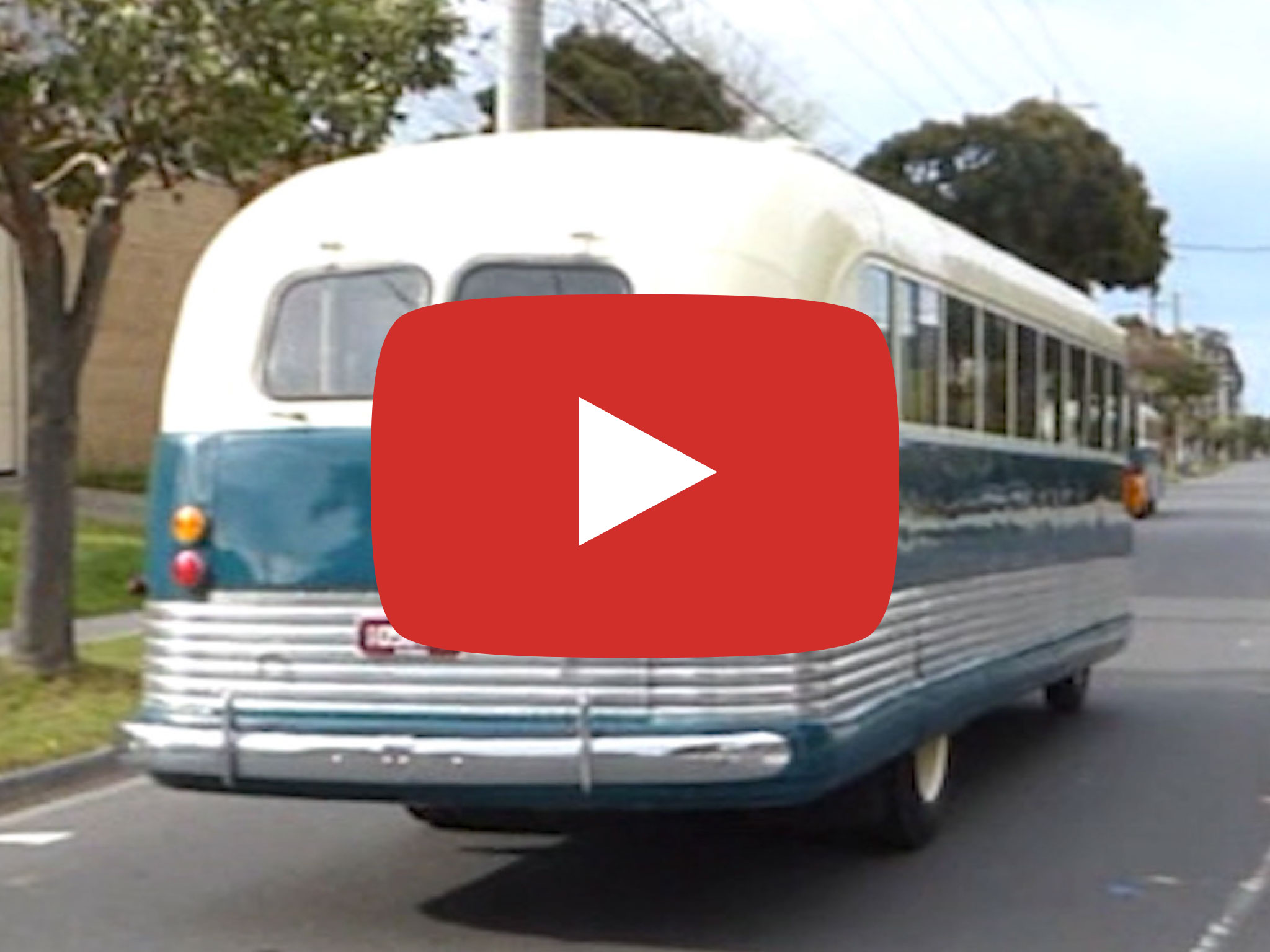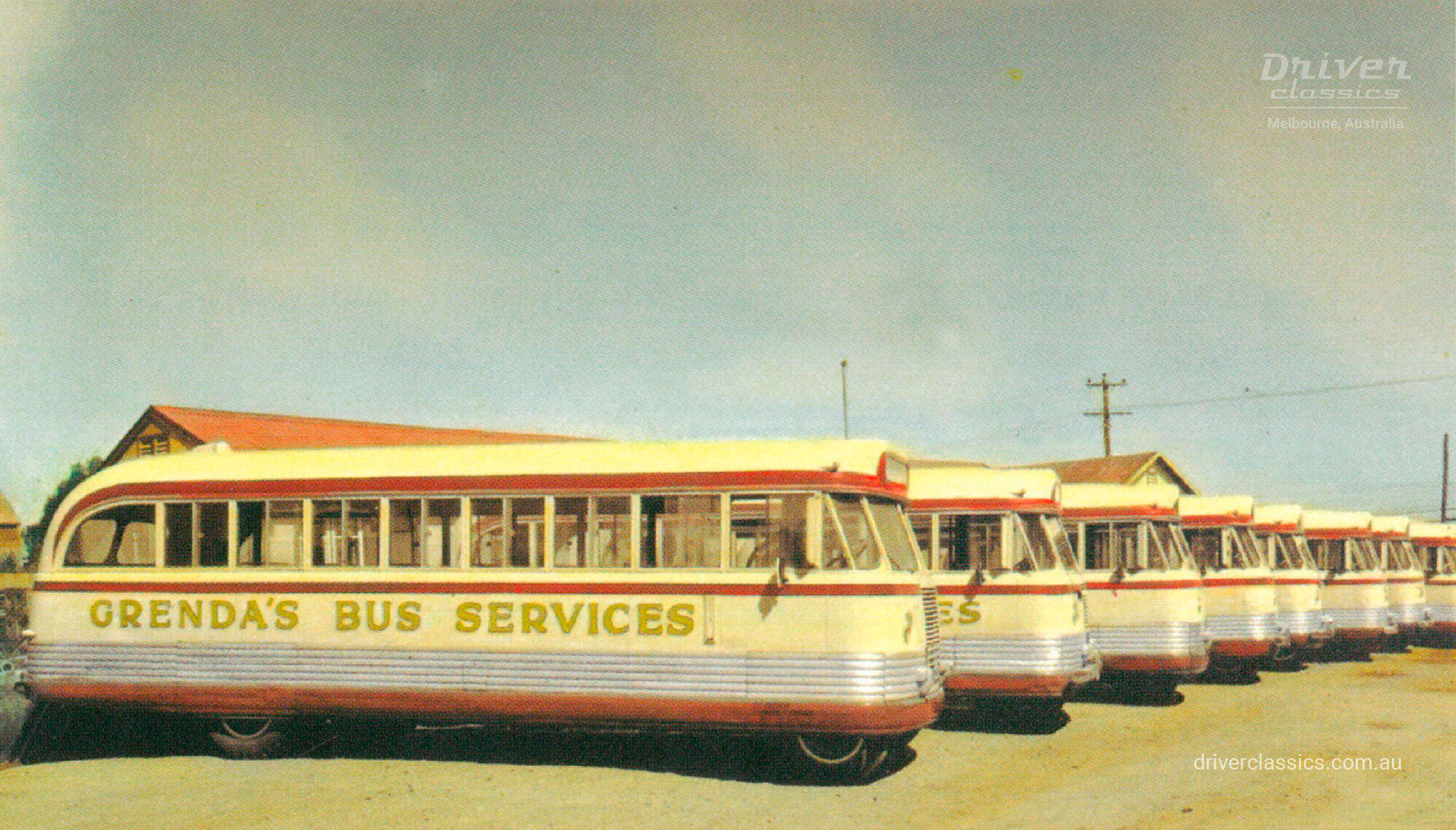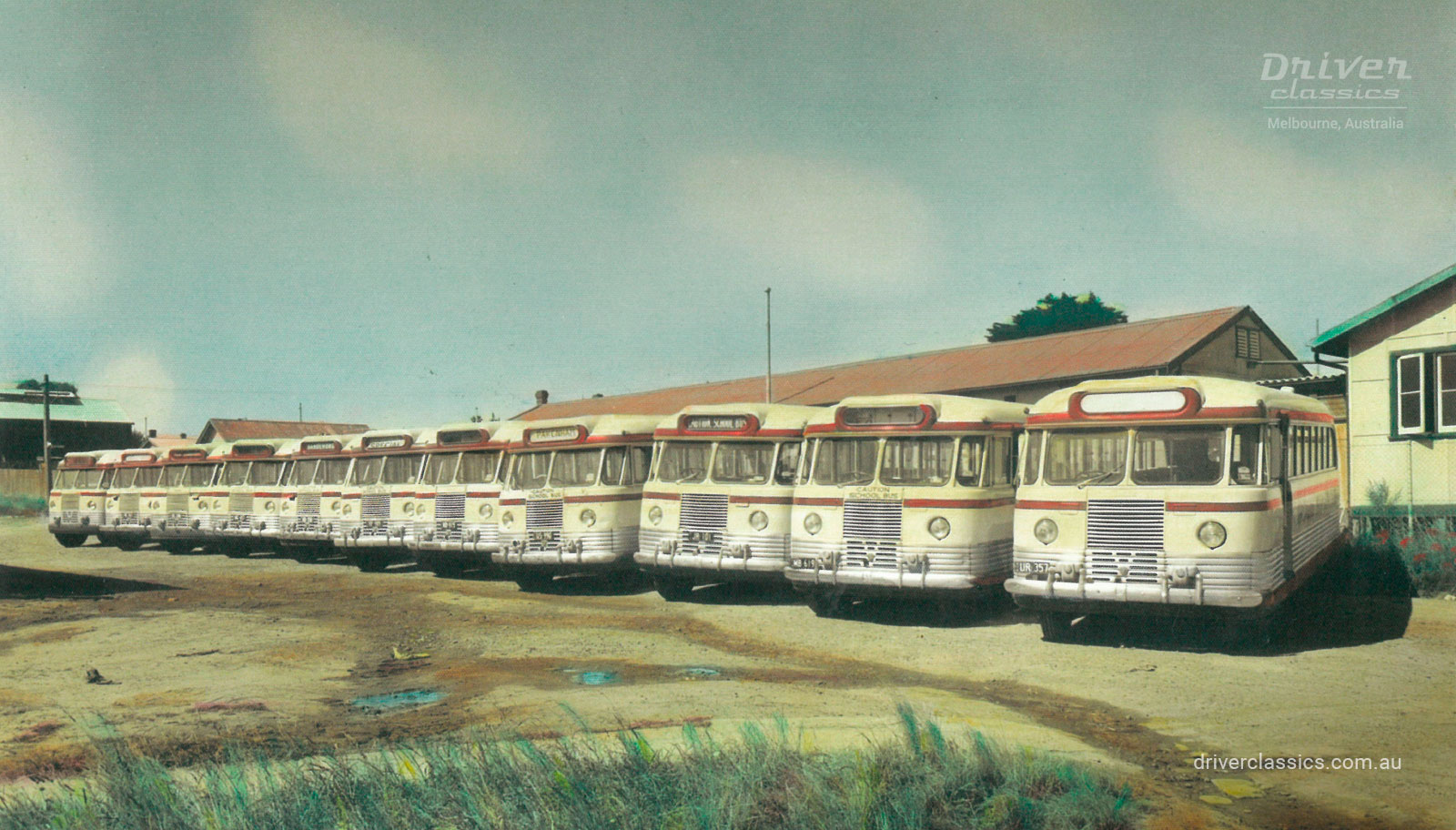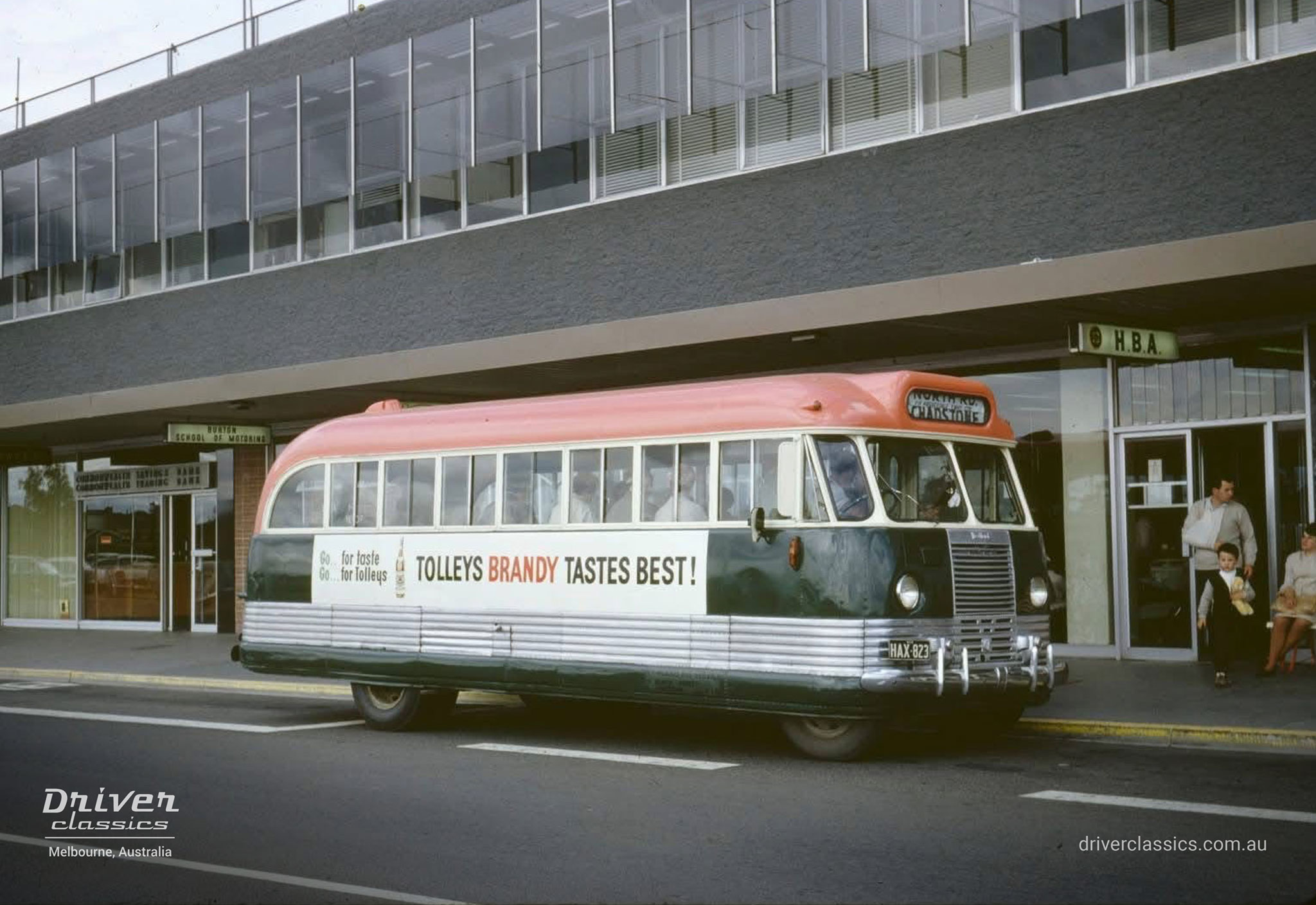1947 Bedford OB
Some loved them, some hated them - but private bus operators depended on them
(Click on photos to enlarge) - Images free to share and distribute but please acknowledge driverclassics.com.au
About This Bedford OB
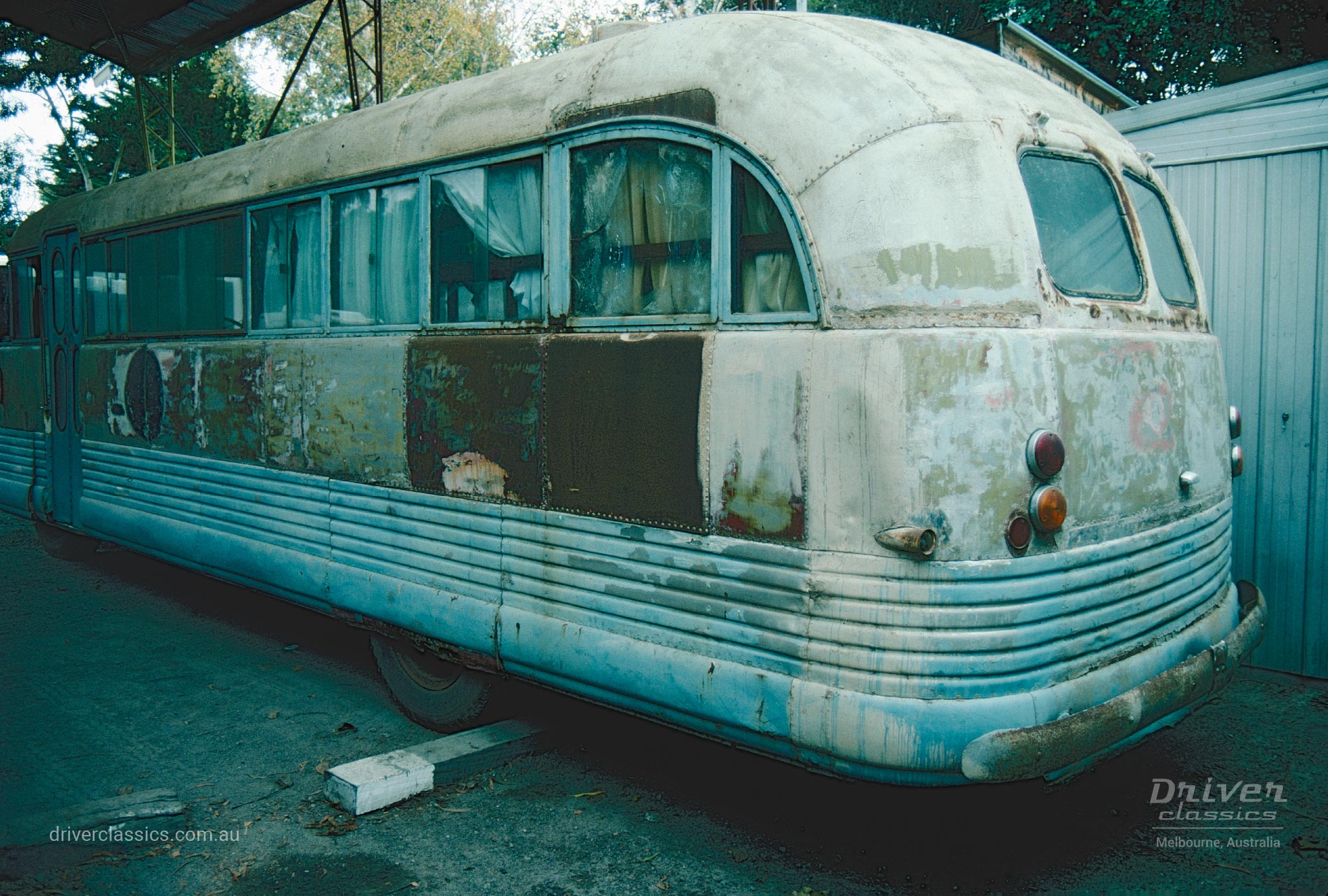
Our Bedford OB was purchased from the Victorian Bus Preservation Association in May 1996 and received a complete ground up restoration. When purchased, our OB which was once fitted out as a motorhome, had evidence of a second door behind the rear axle, although no door was fitted at the time. It originally would have had a passenger operated rear door. It was built as a Bedford “Transit Bus” model featuring the long 201” wheelbase and 31 passengers.
It now represents #3 from the Driver Brothers fleet in 1947. Bedford OB #3 was publicly unveiled in November 2007 at the Historic Commercial Vehicle Show at Sandown in Melbourne.
This Bedford OB is powered by a Bedford 214ci, 6 cylinder petrol engine with a 4 speed constant mesh transmission. Bedford’s OB model designation signifies ‘O’ as the model series and ‘B’ for bus.
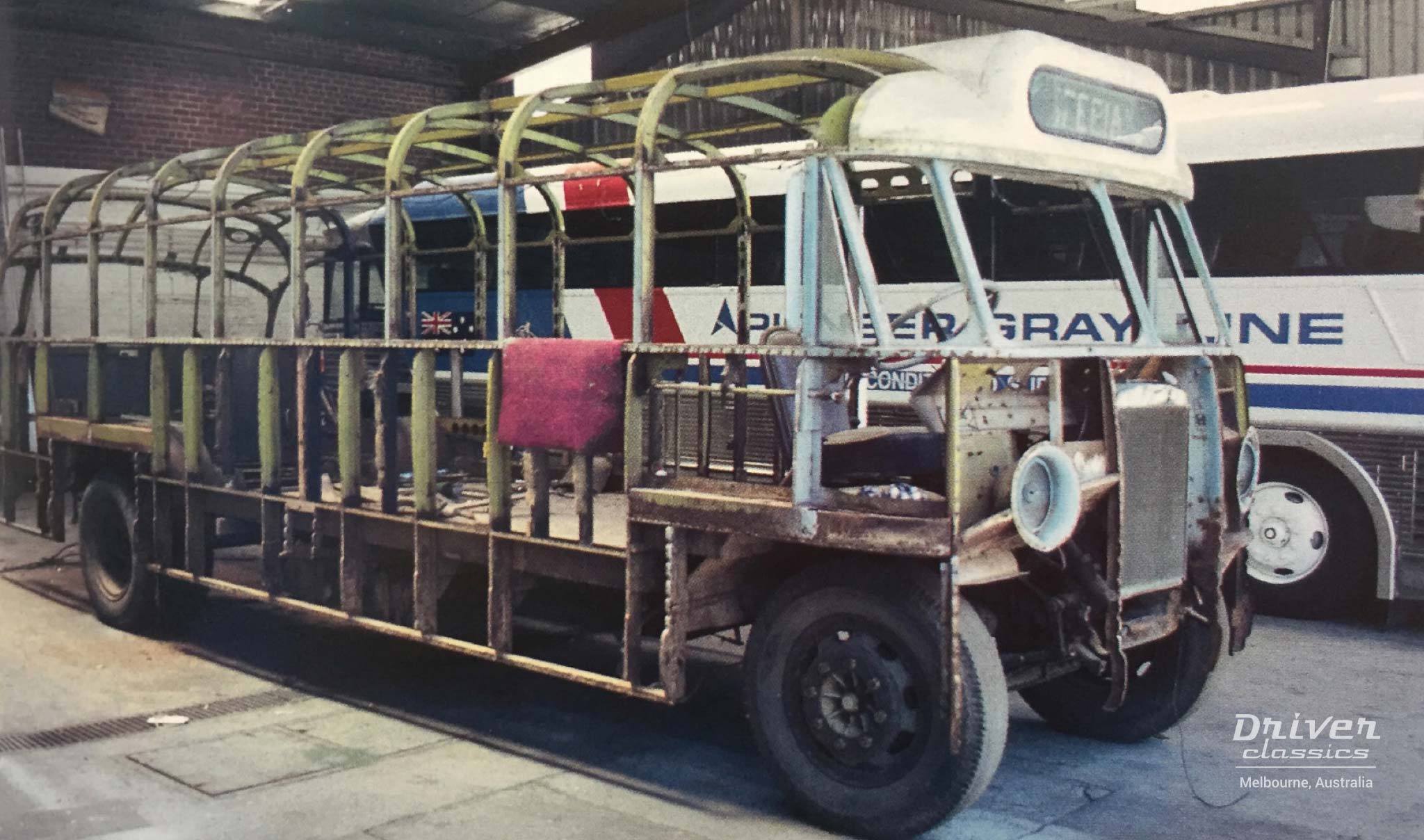
The Story
The origin of Bedford, General Motors' UK division
General Motors UK initially built Chevrolet light trucks and buses for the UK market but in 1931, GM UK launched the Bedford range of local light trucks and buses heavily based on the existing Chevrolet chassis. Bedford’s origins date back to Vauxhall Ironworks, a company set up at Vauxhall, London in 1857 by Scottish engineer Alexander Wilson. Vauxhall moved to Luton, Bedfordshire in 1905 and was bought by American giant General Motors in 1925.
There is no known documentation as to why General Motors Vauxhall chose Bedford as the name of its new UK commercial vehicle brand, but it was most likely because of the location of Vauxhall’s Luton plant in the county of Bedfordshire, in the east of England.
The Bedford OB was designed as a successor to the 1930s Bedford WTB. The first Bedford OB was built in 1939 but stayed in production for only 2 months, with just 73 being built, when all of Bedford’s production was turned over to the war effort.
During the war years, in addition to truck production, Bedford produced 3,398 OWBs along with 5,640 Churchill tanks. The Bedford OWB was a war time austerity version of the Bedford OB combined with bodies that were even more austere. Bodies were designed by Duple and built by Duple, along with other coach builders, to Duple’s design.

Post war production of the Bedford restarted at GM’s Vauxhall-Bedford, Luton UK plant in October 1945. Bedford built 12,766 post war OBs in the UK with ‘O’ series production finally ceasing in 1953. All were conventional (engine out front) with around a dozen being built in forward control layout (flat front/body over engine).
Unlike Australia where Bedford OBs were the most popular choice for private city route service operators, UK Bedford OB production catered for regional commuter service and charter operators. Bedford itself collaborated with Duple to develop the ‘Vista’ coach body for the Bedford OB chassis.
Australian bus body builders such as Syd Wood and Grice, initially built bodies on Bedford OB chassis with conventional layout, however this practice was curtailed with the arrival of General Motors-Holden’s own design body on the Bedford OB chassis.
Bedford OBs in Australia
General Motors-Holden’s Australia (GM-H) began offering Bedford OBs as complete buses in 1947. GM-H Australia imported the Bedford OB chassis from GM’s UK Vauxhall-Bedford division, designed the body, built the body and began selling Bedford OBs as complete buses, rather than body-on-chassis.
The private bus market in Australia before and immediately after WW2 was dominated by conventional layout pre-war buses from US manufacturers, including Federal, White, Diamond T, GMC and Reo. GM-H itself had recently built complete Chevrolet buses.
But GM-H wanted an all-metal forward control bus, that was modern, different, and bold, with a design that would set a new benchmark in Australia.
GM-H constructed a scale model of the Bedford OB that was completed by February 1946, to assist with the building of a full-size prototype OB bus at GM-H’s Woodville, Adelaide SA plant.

GM-H’s Bedford OB body styling was dramatic…with enclosed wheels, the use of aluminium bright work and of course a fully flat front, all quite radical for the day and so different to anything else on the market. The enclosed front wheels were to hide the narrow front track (width) of the 1930s Bedford OB conventional chassis design with the benefit of enabling the streamlined look that GM-H was after. The 1946 GM-H Bedford OB was an odd mix of 1930s British chassis design with modern Australian body style influenced by American styling trends!
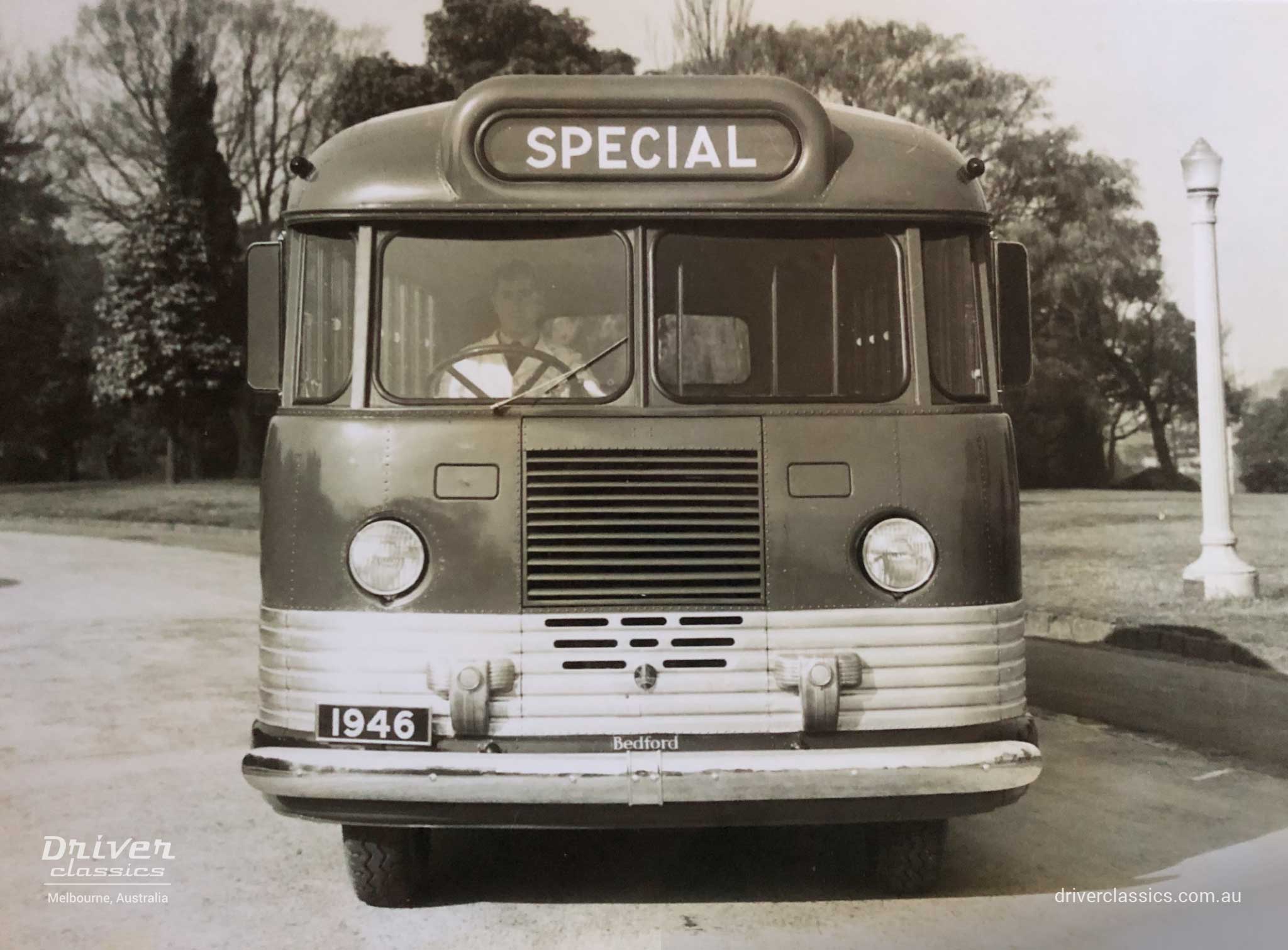

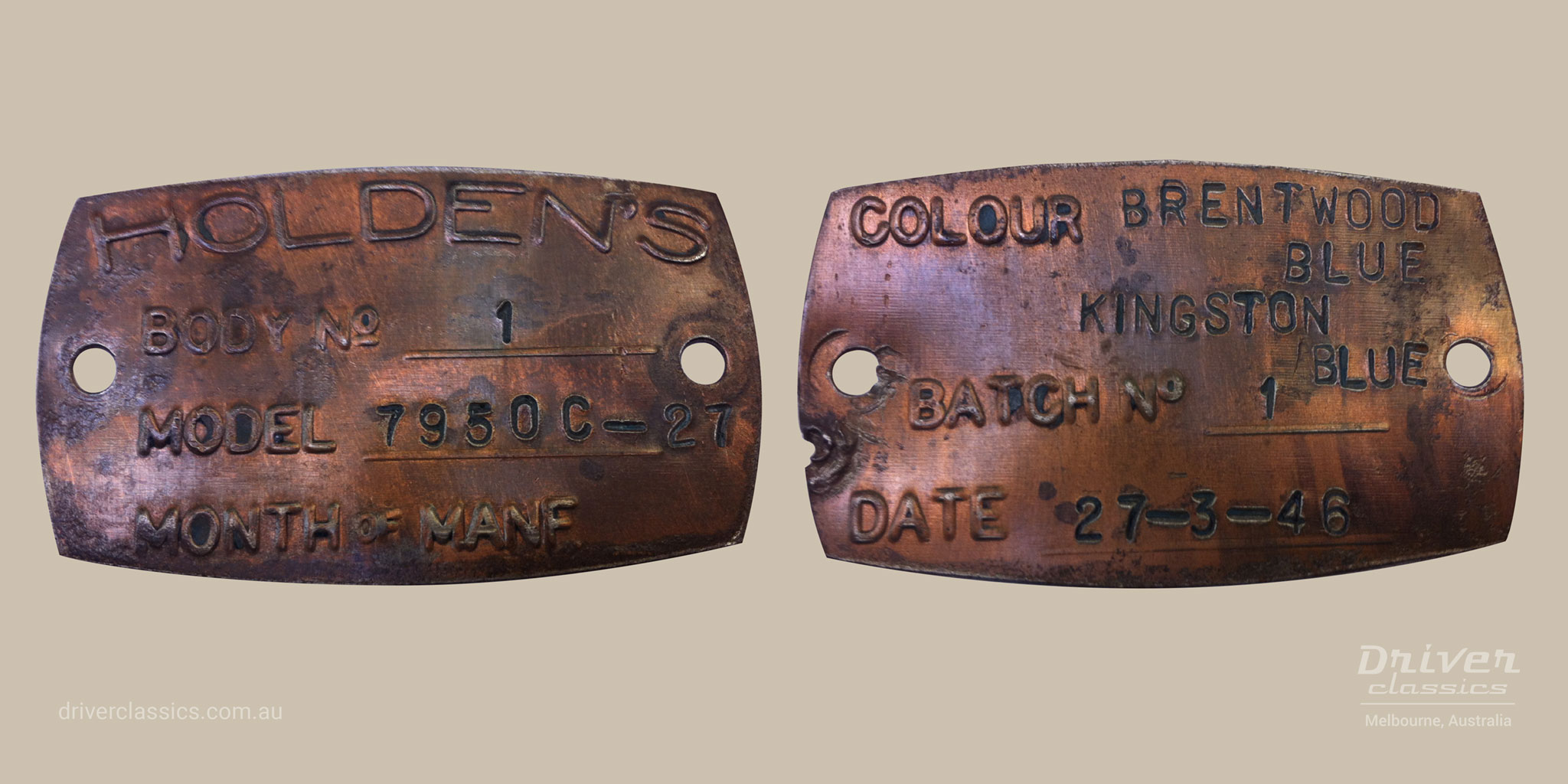
GM-H decided to complete the modifications of the Bedford OB chassis locally at its Fishermans Bend, Melbourne VIC plant. Conventional Bedford OB chassis would arrive from GM’s Vauxhall-Bedford UK plant in CKD form where they were assembled and modified to forward control. To achieve maximum seating, GM-H moved the controls 12 inches further forward and to assist with quite heavy steering, fitted a locally cast 3 inch larger aluminium steering wheel with a 20 inch diameter.
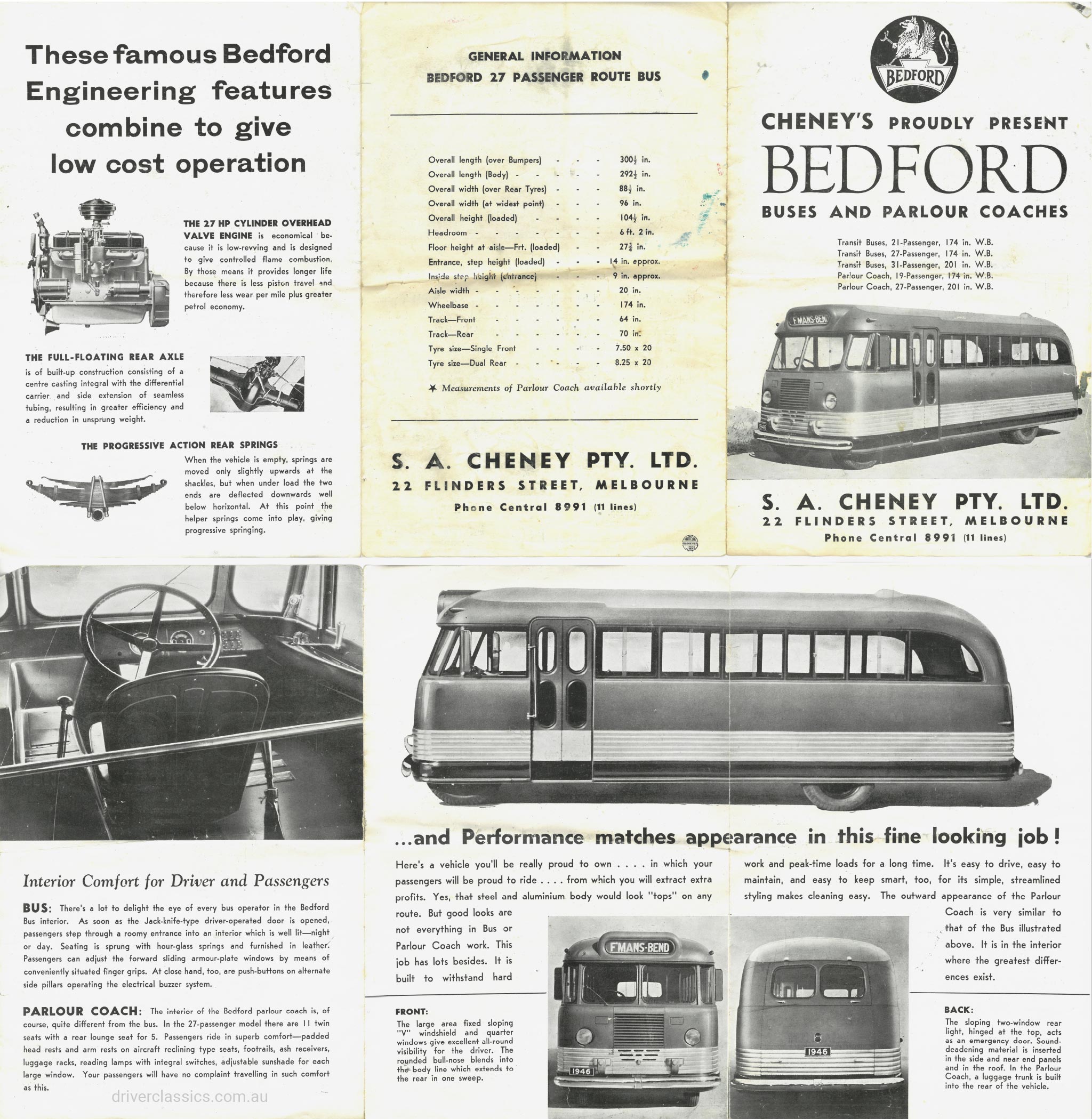
Compared to the conventional (engine out front) buses of the day, the Bedford OB looked more like a spaceship had landed! The all-around aluminium lower bright work styling feature appears to have been borrowed or at least influenced by GM USA’s unique Parade of Progress display buses used in Motorama shows throughout the USA at the time.
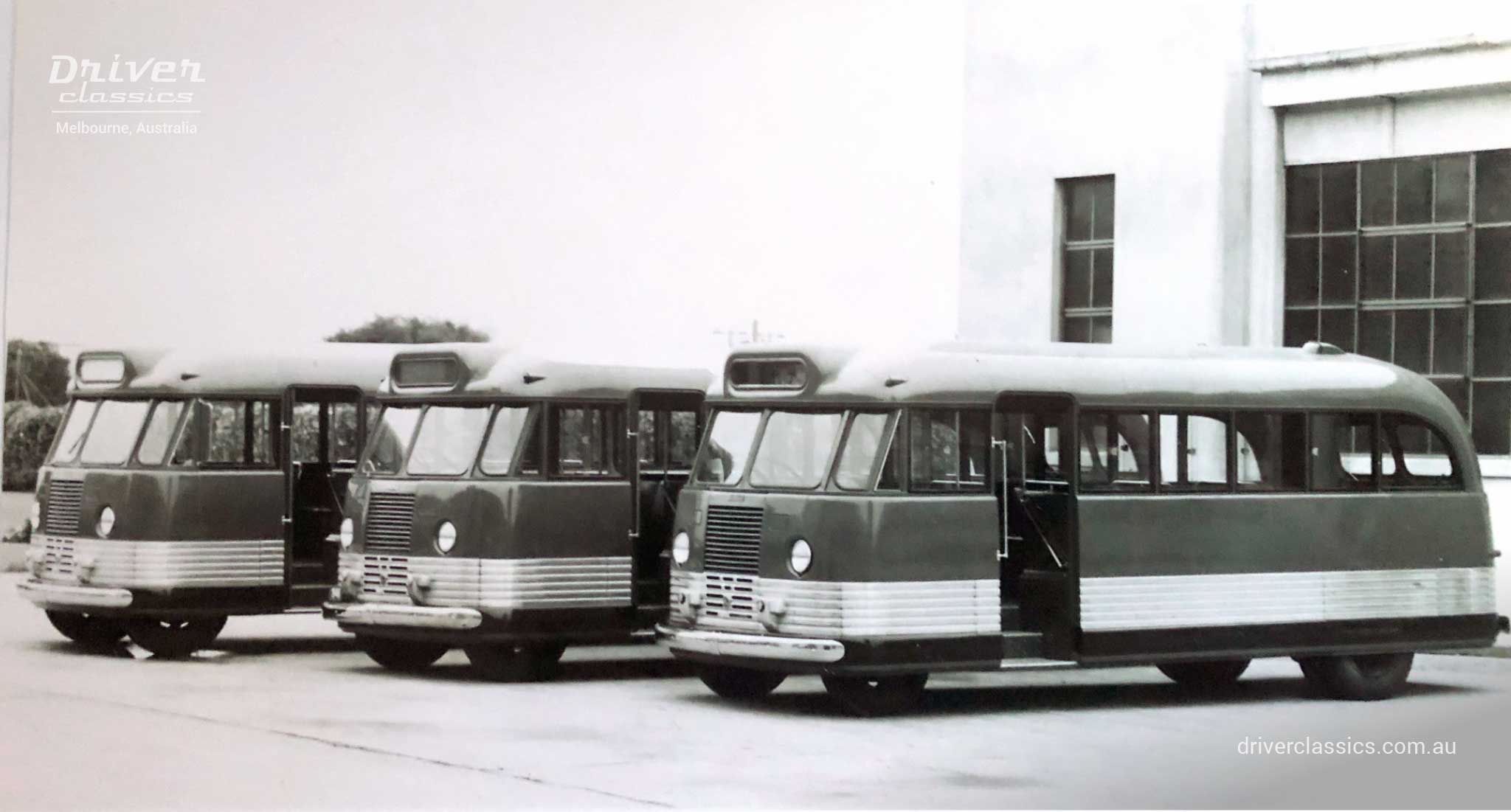
Three Bedford OB prototypes of differing lengths and seat capacities were built by GM-H in 1946. The first prototype, a 27 passenger with body #1, Model #7950C-27, was completed at GM-H’s Woodville plant in Adelaide SA on 27-3-46, while prototype’s #2 and #3, one being a long wheelbase 31-seater and the other a short wheelbase 23-seater, were both likely built at GM-H’s Fishermans Bend plant in Melbourne. It is unclear how many short wheelbase OBs were built, but the Pollard’s, later Britton’s OB pictured in this story, is likely the only one.
A noticeable design difference between the scale model and the full-size bus was the addition of elaborately styled park light fittings on each side above the front bumper. These beautifully designed fittings were added to cover a protruding steering arm on the driver’s side of the bus, owing to the modification from conventional to forward control layout.
GM-H initially built all its bus bodies in-house. It is unclear whether GM-H began building production Bedford OBs in full volume only at its Fishermans Bend Melbourne plant, or if some were built in low volume at GM-H’s Woodville, SA plant.
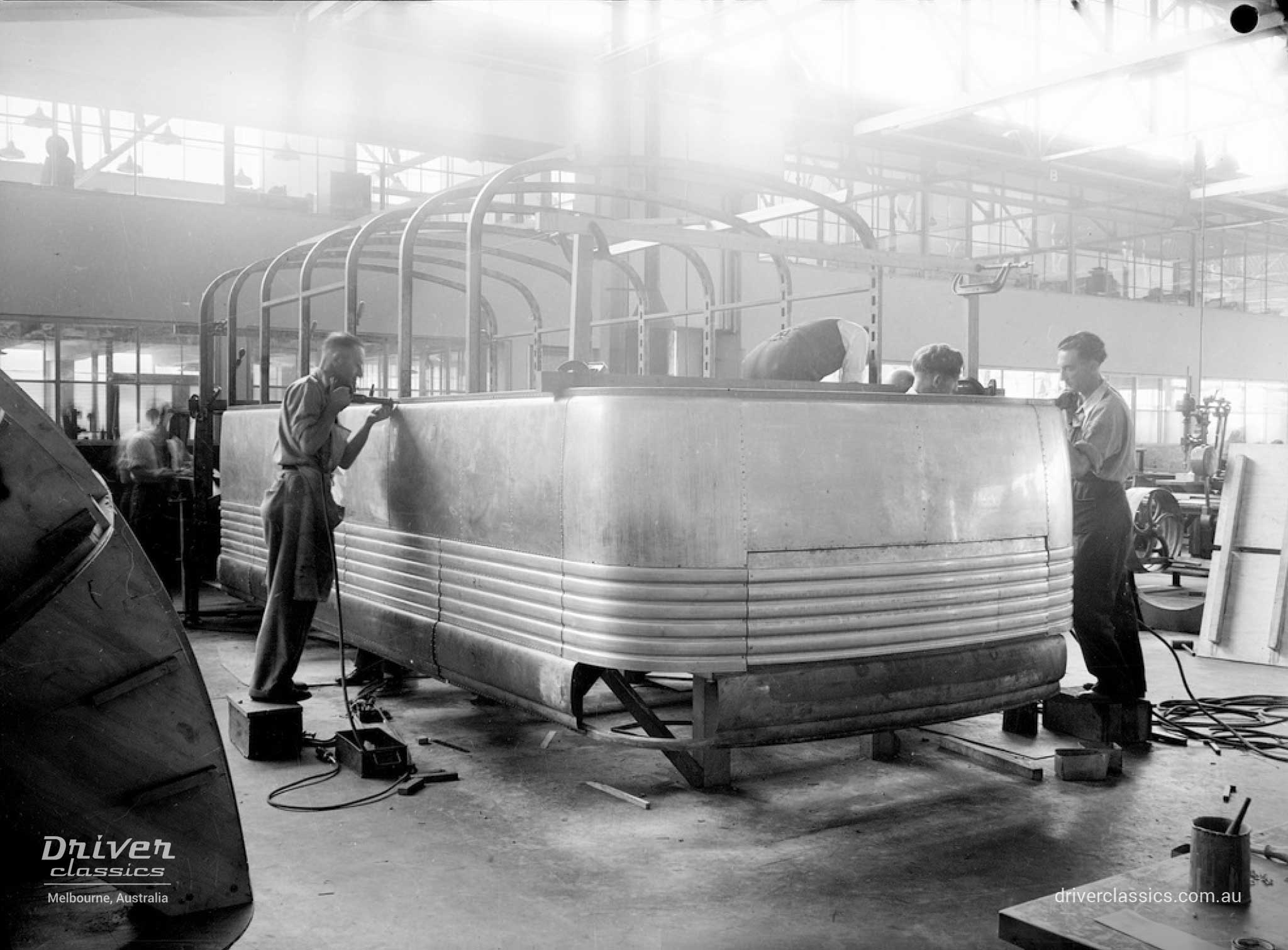
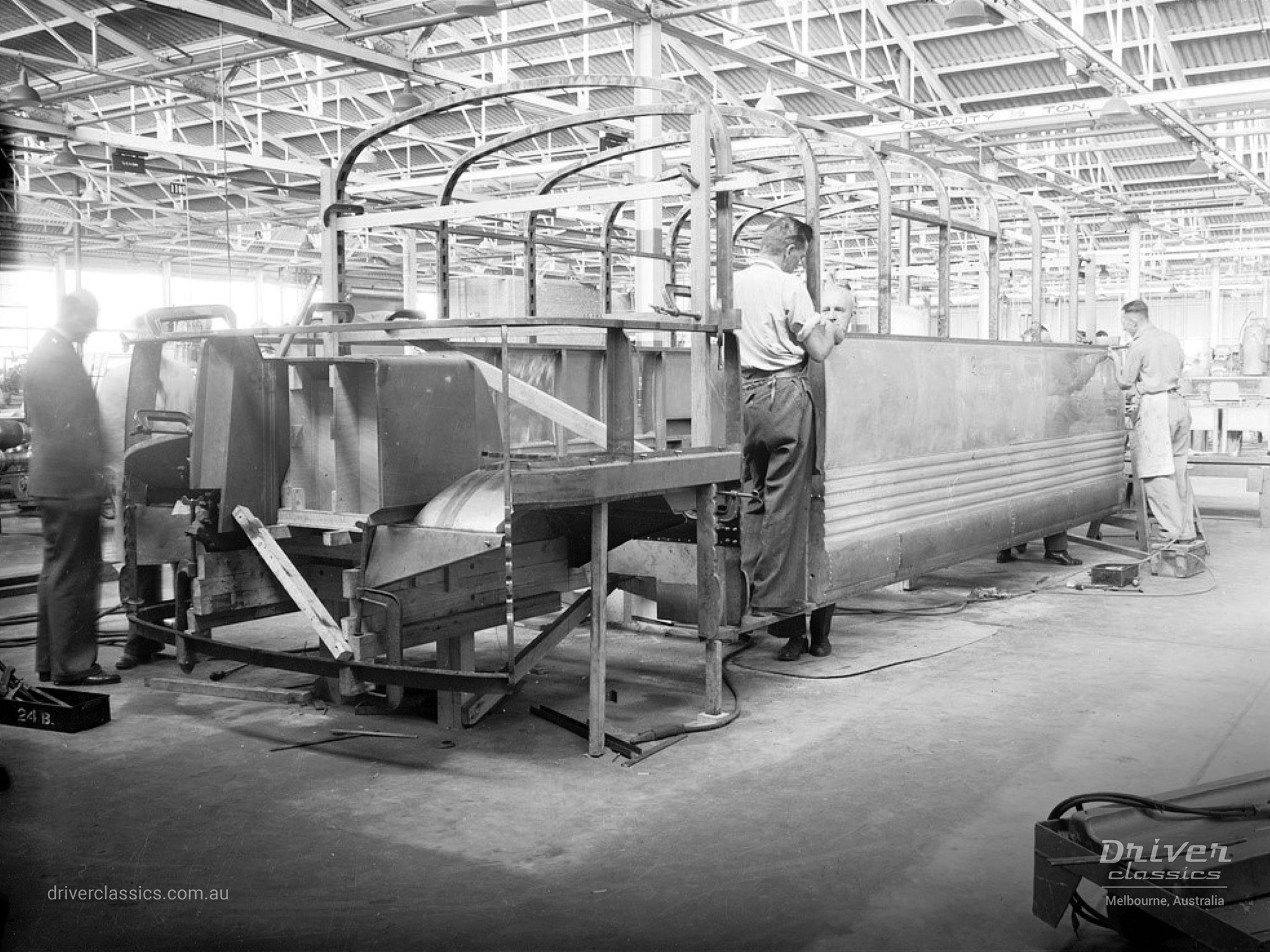
In mid-1946, the first prototype GM-H Bedford OB with body #1, now relocated to Melbourne, was loaded with cement by engineers and tested at GM-H’s Fishermans Bend proving ground over a rugged course, endeavouring to show up any weakness in design or materials. By all accounts it fared well. GM-H then used the 27-seat prototype as a show vehicle and exhibited it at Melbourne and Sydney shows.

In late September 1946, GM-H sold its Melbourne built 1946 Bedford OB, short wheelbase prototype, to Pollards Tours, Healesville VIC after it was exhibited at the Royal Melbourne show in September 1946. Pollards Tours was a family business managed by Robert J. (Bob) Pollard and was eventually sold to Ansett Pioneer in December 1949. Bob was asked to stay on by R. M. Ansett and continue managing Pollards under Ansett ownership, which he did. Bob would later go on to become Operations Manager of Ansett Pioneer and was instrumental in importing Pioneer’s GM PD-4106s in 1961.
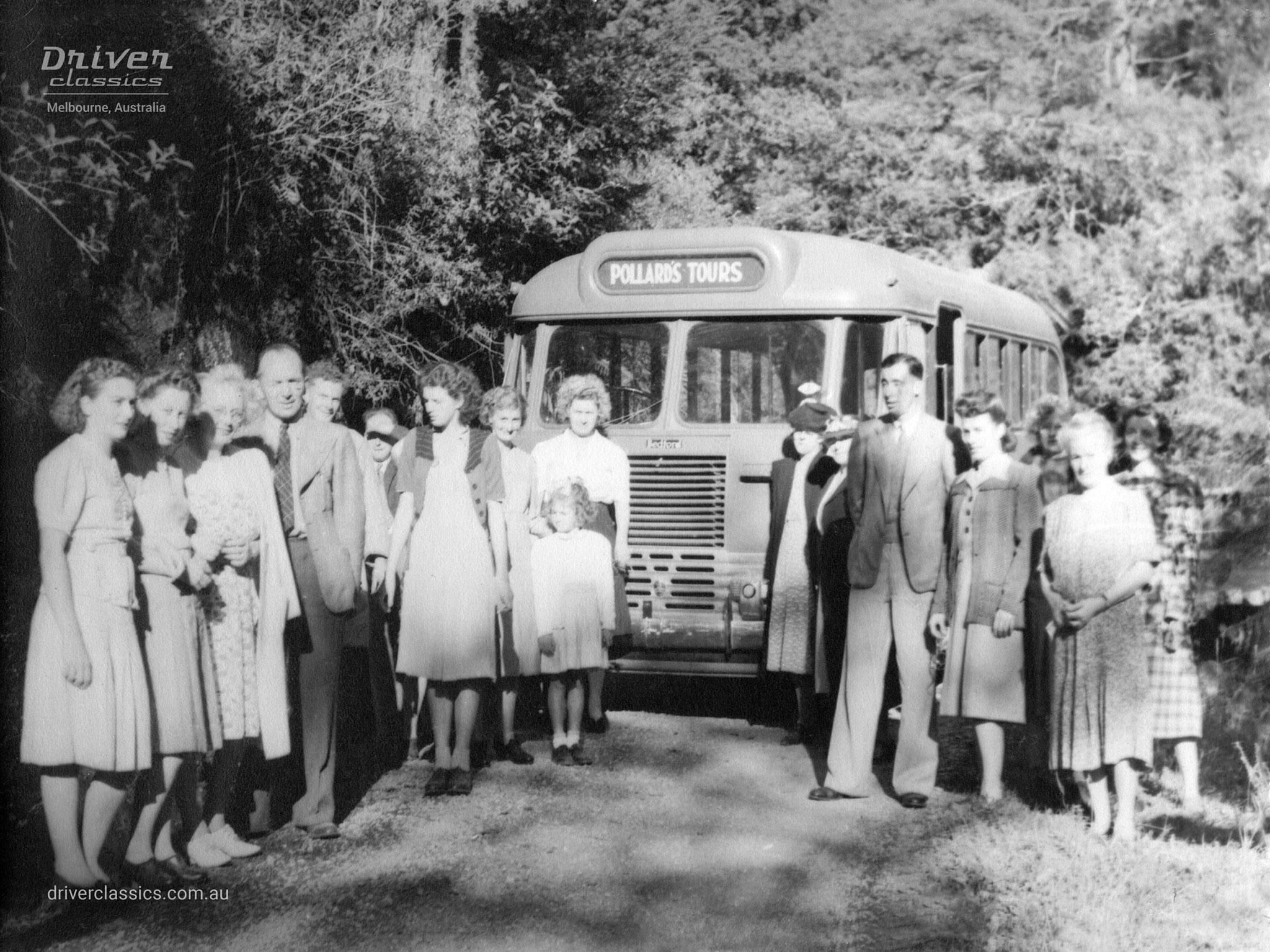
The Adelaide built 1946 Bedford OB, mid-size wheelbase prototype, body #1 was soon after acquired by Mr and Mrs Jones from Smithton, Tasmania, with 4,000 miles on the clock, for use as a school bus and for charters. According to a story in the Tasmanian Advocate, Mr Jones said ‘the engine was never cold’ as it carried people to all parts of the island state. At its retirement from passenger work, Mr Jones estimated that ‘the OB had covered over 1,000,000 miles and carried well over 1,000,000 passengers!’ It did have 6 different engines in that time, but much of the gear box and all the differential remained original, and the bodywork is still sound.
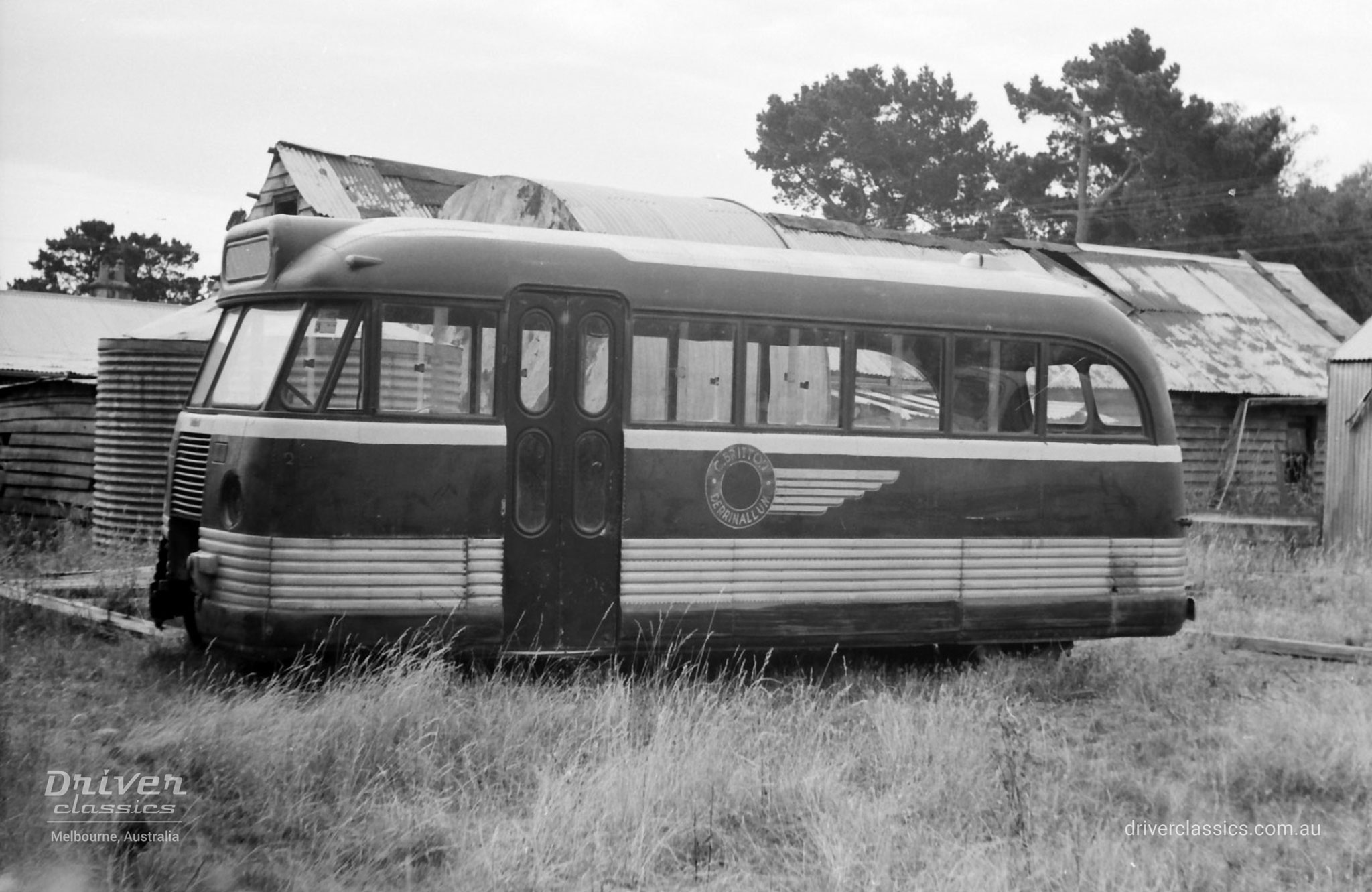
The impending introduction of GM-H’s new Holden motor car required all resources to be redirected to Holden car production. GM-H needed to find a different way of building bodies on its Bedford OB chassis. By mid-1948, GM-H began outsourcing the body building task to Commonwealth Aircraft Corporation (CAC) of which GM-H was a shareholder. CAC was located nearby to the GM-H Melbourne plant.
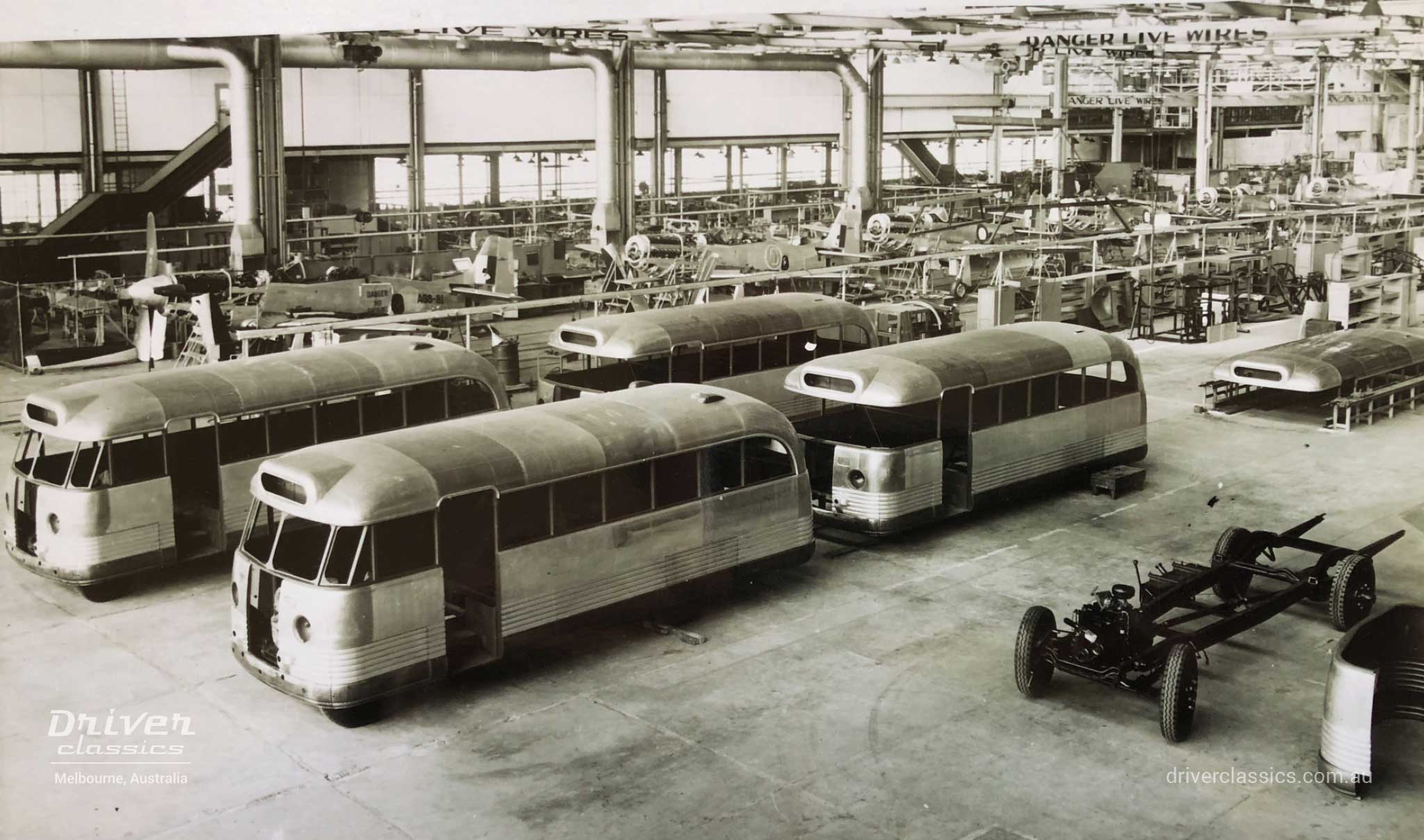
CAC was a builder of aircraft, but as WW2 had recently ended, CAC was looking for additional work to maintain its staff levels. The contract offered by GM-H suited CAC, so they began building buses right alongside aircraft production lines.
GM-H established exclusive distribution of Bedford OBs through its dealer network while withdrawing the opportunity for other bus body builders from building on the Bedford OB chassis. However, the similar Bedford ‘O’ series conventional truck chassis was still accessible by other bus body builders.
GM-H advertising from the period, promoted the Bedford OB as the ‘Forward control Bedford “Transit” …the better bus’, in 27 and 33 passenger variants on two different wheel bases.
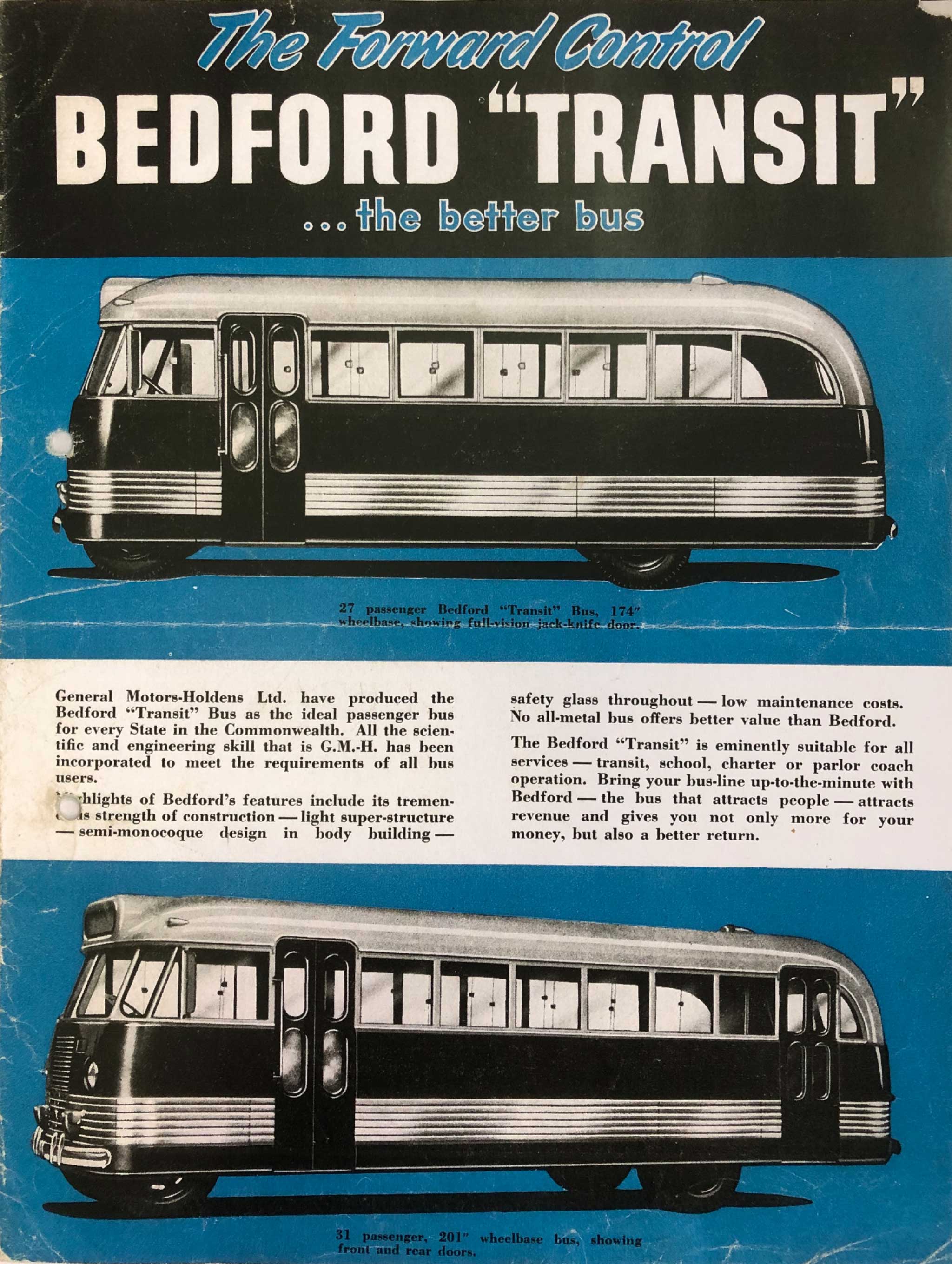
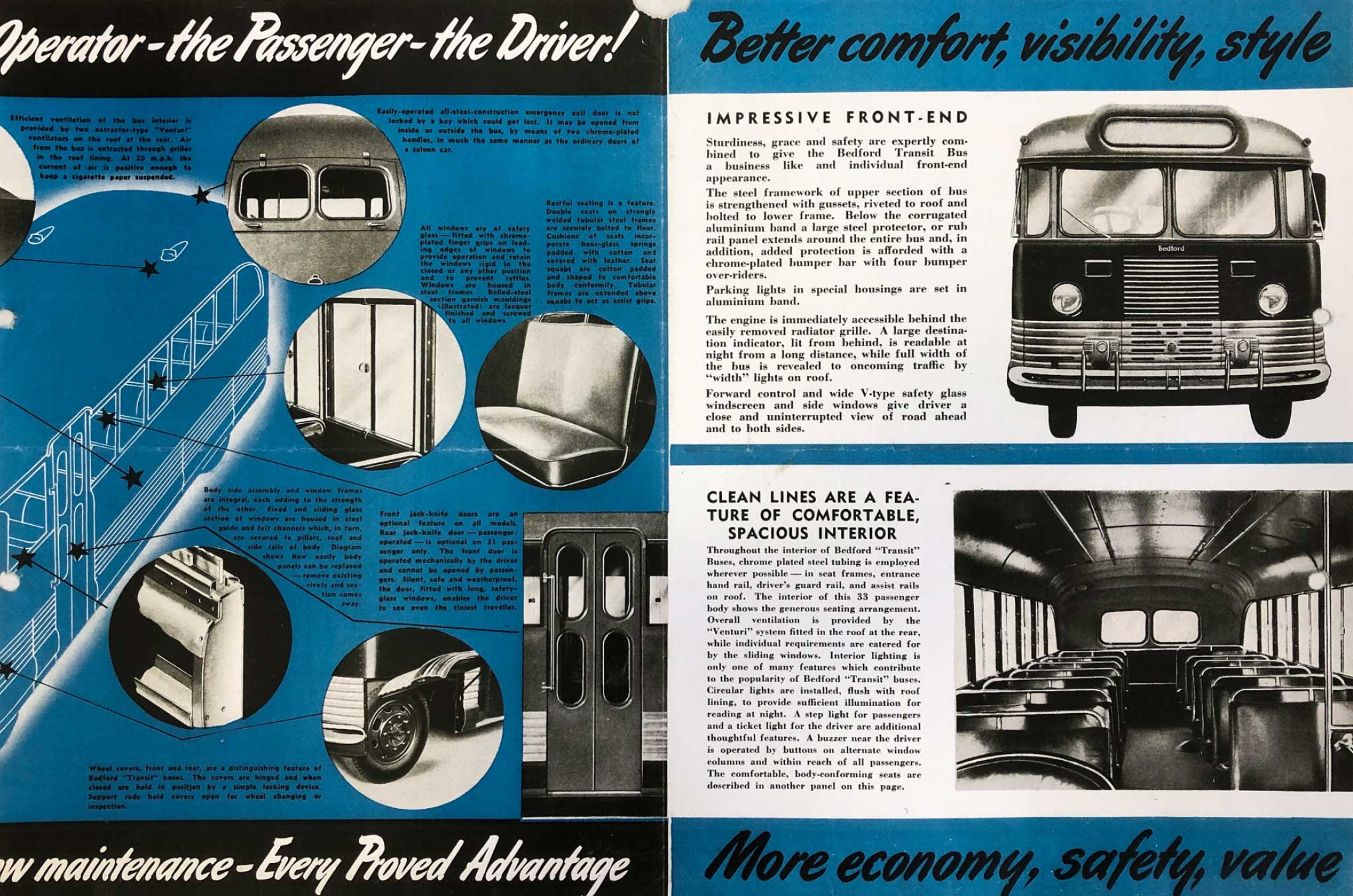

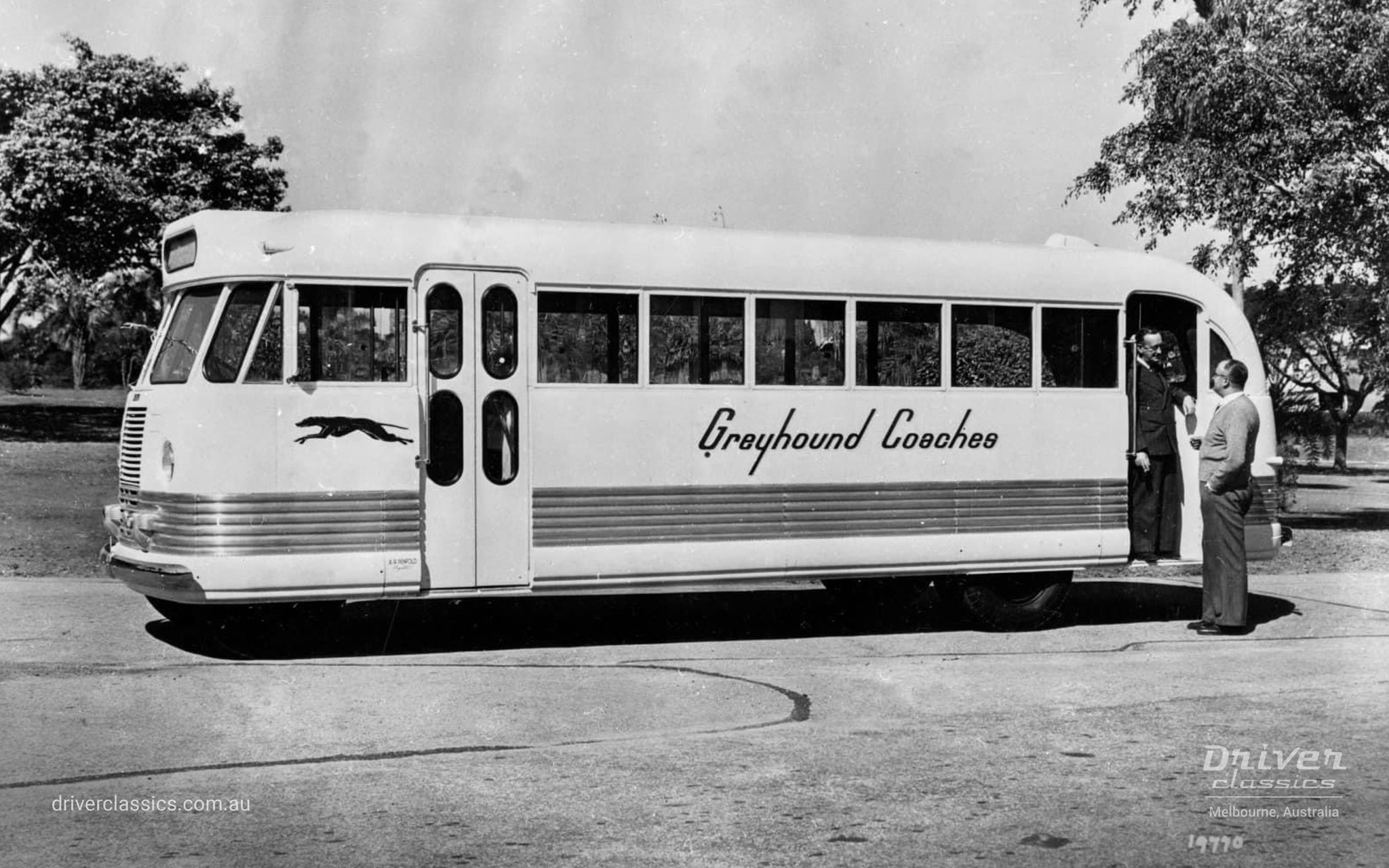
The Bedford OB was hugely successful for GM-H in Australia with 932 produced (plus the Adelaide prototype) from 1947 until 1952, at which time it was replaced by the larger forward control Bedford SB series. The Bedford OB’s modern forward control layout combined with government post war currency restrictions limiting trade with the USA, resulted in the Bedford OB dominating the Australian private bus market, especially in the State of Victoria.
The Bedford OB was a work horse of a relatively basic design. Drivers and owners either loved them or hated them…sometimes at the same time. The high pitched whine of the transmission was perhaps its most notable and endearing feature, but above all it was cost effective and reliable, attributes sorely needed after WW2.
Driver Brothers purchased Bedford OBs after WW2 and continued purchasing Bedford OBs, SBs, VAMs and a single YRT until the 1970s with the last Driver OB still operating in commercial service in 1967.
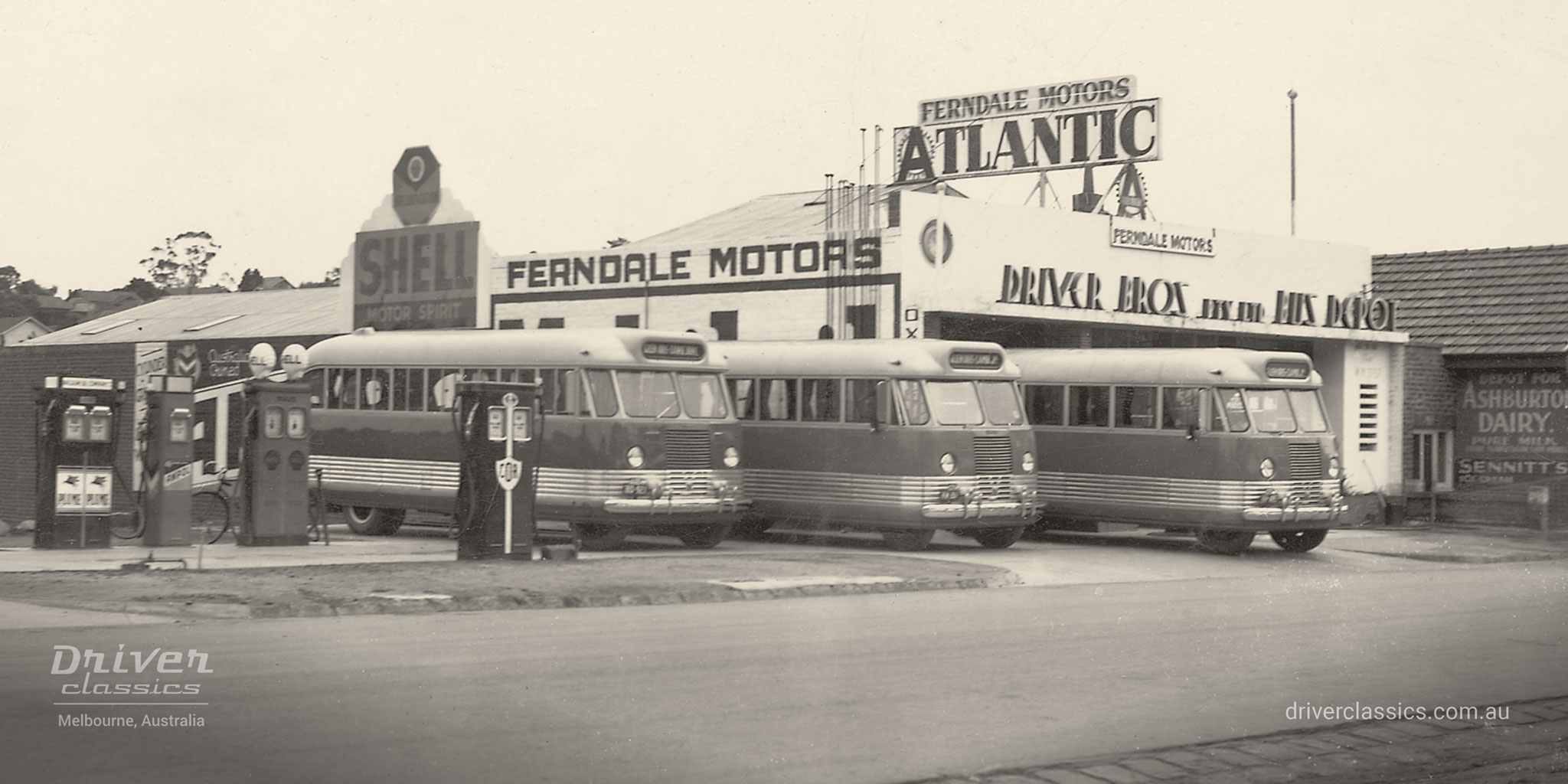
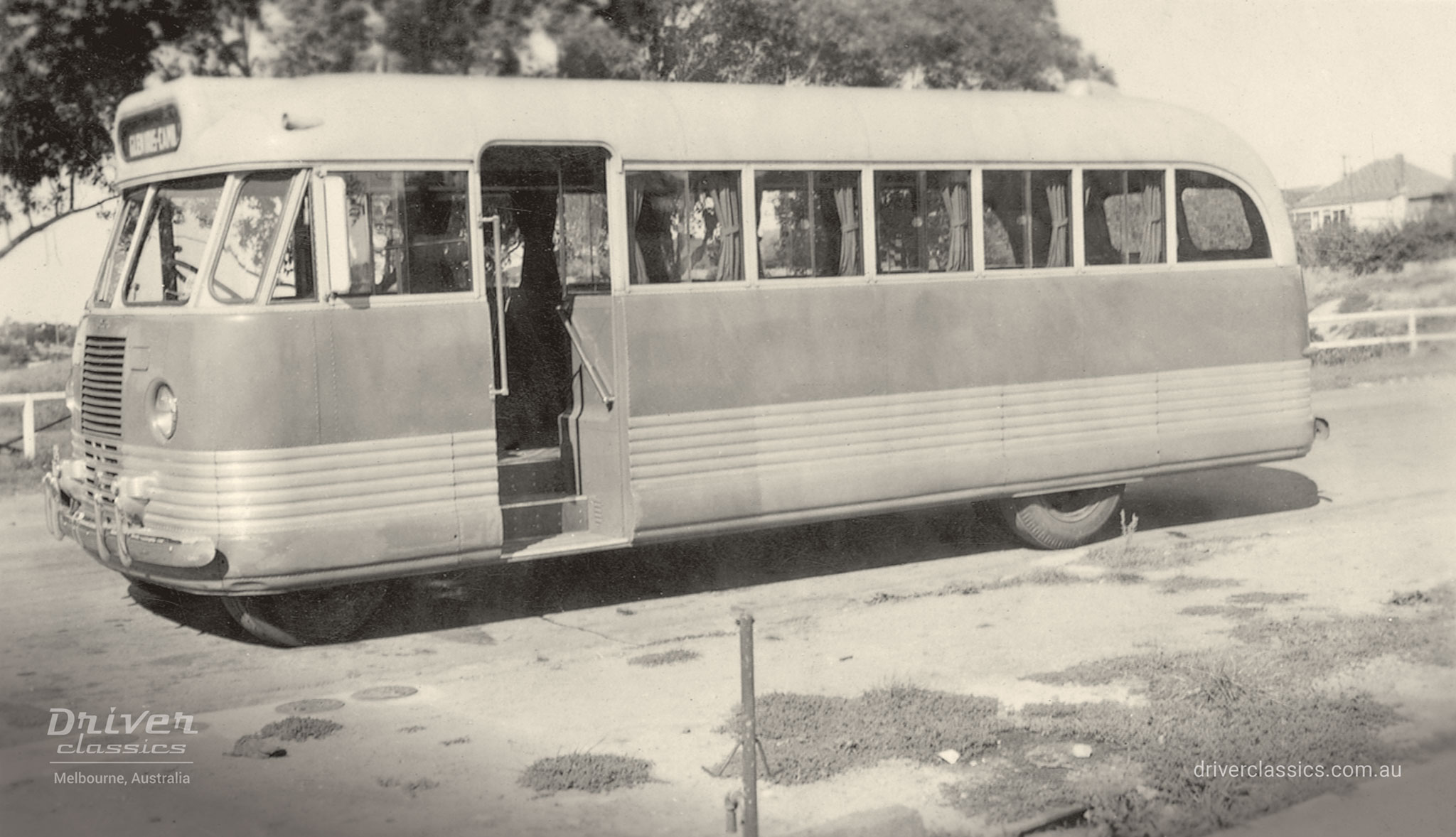
-

1936 Federal
-

1947 Bedford OB
-

1948 GM PD 4151
-

1954 Flxible Clipper
-

1959 Bedford SB3
-

1961 GM PD-4106
-

Ansair Scenicruiser
-

1968 GMC PD 4107
-

1972 MCI MC7
-

1976 MCI MC8
-

1983 GM Denning
-

1984 Eagle Model 10
-

1988 Denning Landseer
-

1989 Eagle Model 20
-

1977 Kenworth W925
-

1950 Dodge Pick Up
-

1959 Cadillac
-

1961 Cadillac
-

1962 Ford Thunderbird
-

1968 Ford Fairlane
EX HERITAGE FLEET

